While the New Manchester Group were popularly regarded by the later 1950s as leaders of a British wing of Darmstadt-style musical modernism, they were hardly alone in their awareness of trends being promulgated forcefully by European contemporaries. Boulez's assertion that “all composition other than twelve-tone is useless”Footnote 1 was famously brash (even down to his polemic-italics), but his critique of Schoenberg's own serial music as “twisted romantic classicism” set the scene, in 1952, for a decade of debate among younger composers. Boulez's call was for a new language, moving beyond Schoenberg's traditional melody-accompaniment textures and “poor, even ugly, rhythms.”Footnote 2 His suggestion that row organization should structure non-pitch parameters – duration, tone-production, intensity, and timbre – was taken up most directly by the younger composers who visited Darmstadt in the 1950s, but such thinking quickly permeated discussions internationally. In the Cold War standoff, serial thought was itself portrayed as a supra-national phenomenon (a position with its own ideological charge),Footnote 3 but beyond journalistic bluster and artistic posturing, British responses centered on the questions of structure and style framed by Boulez. Davies, in a feisty 1956 article, rebuffs claims that newer techniques were “too cerebral to be compatible with what is called ‘musical expressiveness.’”Footnote 4 His early works, like those of Goehr and Birtwistle, were received with excitement or dismay, but in either case, were taken as accomplished reflections of what Darmstadt radicals had to offer; the Manchester colleagues attracted the publicity they did (“Modernest Moderns”) precisely because they were articulating the artistic concerns of many in their generation, and of some slightly older.
Glock's Score magazine – the venue for the Boulez and Davies articles just quoted – published ongoing debate on serial aesthetics throughout the 1950s, engaging American critics alongside British and European commentators. For British musicians by decade's-end, serialism was no mere novelty,Footnote 5 and in 1960, Iain Hamilton, writing for Tempo, confidently hailed row composition and non-tonal music as “the great new forces of our time.” His article, entitled “Serial composition today,” spoke of an escape from “the tyranny of theme,” a pre-Classical harmonic ideal of “hearing by interval,” and the importance of Webern's music – all commonplaces of the debates at Darmstadt.Footnote 6 Hamilton's praise for limited performance freedoms in Stockhausen's Zeitmaße (1956) and the melodic arabesque in Boulez's Improvisation II (1957), meanwhile, reflect the evolving stylistic profile of the self-consciously new. In considering how the Manchester composers faced up to the task of forging a compelling language, in Chapter 3 I focused on broad questions of form, thematic rhetoric, drama, and the projection of poetic meanings; turning now to the work of their colleagues, comparable ideals of craft and aesthetic remain in play, as they worked themselves out in the distinctive voices of Thea Musgrave, Nicholas Maw, Gordon Crosse, and Richard Rodney Bennett.
Framing these four as, in effect, a “Manchester generation” of British composers, this chapter seeks to detach the British role in the post-war avant-garde from a simple narrative of admiring emulation of European models among a few hard-liners, and to move beyond the geographical confines of Manchester and Darmstadt. Greater Manchester itself, after all, was less actively a center of British compositional innovation after 1957, the year Davies completed post-graduate teacher training (at Salford) and left for Rome. Richard Hall himself left his teaching post at the Royal Manchester College of Music in 1956; Goehr and Birtwistle had graduated in 1955, Goehr moving to Paris for the Messiaen class, Birtwistle to Oswestry, to fulfill national service. By 1957, they were both in London. All three of the Manchester Group had visited Darmstadt by this point. Here, they met Bennett, and his fellow Royal Academy students Susan Bradshaw and Cornelius Cardew. The Paris-Rome-Darmstadt triangle that defines the European arena of British musical modernism also takes in the remaining “generation” figures. Musgrave, after reading Music at Edinburgh University, spent over four years (1950–54) in Paris with Nadia Boulanger (where John Lambert was a fellow-student). Maw, another RAM student, also pursued post-graduate studies in Paris, initially with Boulanger and then with the Schoenbergian Max Deutsch. Crosse (after Oxford) studied with Goffredo Petrassi in Rome in 1962.Footnote 7 Even so, a map limited only to European “centers of tradition” (to recall John Cage's phrase)Footnote 8 will miss crucial encounters, such as Musgrave's with Milton Babbitt and Lukas Foss at Tanglewood in 1958. Back in the UK, the network of personal and professional associations centers on Glock's Dartington Summer School, where all of the British composers named so far frequently taught, studied, and performed together.
The years 1959 and 1960 were a sort of high-water mark for the public discussion of serialism in British music, and it is no coincidence that it is at this point that Musgrave, Maw, Crosse and Bennett experimented variously with a personal conception of twelve-tone technique. If the mid-1950s had seen a peak of Darmstadt's institutional authority as a center of serial orthodoxy,Footnote 9 a natural process of dissemination brought the latest writings of German, French, and Italian colleagues to British composers’ attention. Goehr's anonymous translation of the first volume of Die Reihe, the journal edited by Stockhausen and Herbert Eimert, appeared in English in 1958; translations of volumes II–IV (mostly by Leo Black) followed over the next couple of years.Footnote 10 Colleagues with otherwise disparate interests – Birtwistle and Hamilton, for example – took up strict row-based composition during this period. With Glock's arrival at BBC Music, British composers and audiences were suddenly hearing live or broadcast performances of, for instance, Boulez's music.
The late-1950s interest in serialism could be viewed as one more manifestation of the zeitgeist, the product of a society engaged by novel concepts of systemic complexity. The Whitechapel Gallery's 1956 exhibition This is Tomorrow explicitly repositioned art and architecture into a “general framework of communications.”Footnote 11 “Painting becomes construction,” the catalog observes: “Constructed art, which began with New-Plasticism and Constructivism, is still at a very early stage. It is not, as the status quo holds it to be, merely a past phase.”Footnote 12 C. P. Snow's The Two Cultures lecture (1959) diagnosed a polarization of scientific and traditional viewpoints for high-brows; Northcote Parkinson's magazine articles on modern corporate bureaucracy treated comparable anxieties with gentle satire (“The thing to be done swells in importance and complexity in a direct ratio with the time to be spent”).Footnote 13 Musical serialism appeared to many an obvious case of scientific rationalism invading the artist's atelier; one response to Darmstadt-style radicalism was to dismiss its doctrinal rigor, as Goehr's October 1959 radio talk “Is there only one way?” did, trenchantly.Footnote 14 Just five years on, Andrew Porter, reviewing new British music, concluded that “total serialization and aleatory techniques were Darmstadt fashions never acclimatized.”Footnote 15 Tracing the music of Musgrave, Maw, Crosse, and Bennett from about 1958 through the mid-1960s, it is possible to concur with Porter, while observing the variety of aesthetic and technical positions among British composers sympathetic to aspects of Darmstadt's high-modernist ethos. “Each composer fights his own personal battle,” Hamilton observed, speaking of technique. His military metaphor marks the forces of resistance at large in British culture, yet his emphasis on the idiosyncratic nature of artistic practice rings true in the case of the four Manchester-generation figures.
For Musgrave (born in 1928), writing with rows was a technical experiment made after several years’ professional activity – her first twelve-tone piece dates from 1958 – one she pursued vigorously for only about three years. Triptych, a Chaucer cycle for tenor and orchestra, was given at the 1960 Proms, but by 1962, she was already moving away from strict adherence to pitch rows. Maw (born 1935), too, adopted ordered pitch rows only for a short period, though since he was seven years younger than Musgrave, his first encounters with atonal repertory occurred early in his student years (“when I got to the RAM, I came across the second Viennese school with a bang”).Footnote 16 Maw's Six Chinese Songs (1959) sound more “post-Webern” in manner than do Musgrave's scores, and yet Maw's breakthrough, with Scenes and Arias (1962), to a sumptuous lyricism rife with post-Romantic echoes, sounded a more abrupt turn from avant-garde progressivism than his colleagues’ works of the same period.
The “crisp, analytical” sounds of Musgrave's Triptych, according to one Times reviewer, revealed “more attention to imagery and stress than progressive composers nowadays think necessary.”Footnote 17 Reading Triptych and Maw's Scenes, the composer's response to the chosen text will be a central question, no less crucial to questions of “structure” than that of chromatic pitch orderings. In the other Manchester-generation scores to be examined – Crosse's Elegy (1959, rev. 1961) and Concerto da Camera, Op. 6 (1962), Bennett's Five Studies for piano (1962–64) and Symphony No. 1 (1965) – the focus shifts to instrumental scoring in forms lacking literary support. Crosse's serial works synthesized two of his musical interests as a student – Webern, and fifteenth-century polyphony – and he has also acknowledged the influence of Davies on his early music. Of the four composers treated here, Crosse alone published works that apply serial orderings to durations as well as to the pitch domain. Bennett's serial development resists précis, in that, unlike his colleagues, he did not “adopt” twelve-tone rows by way of passing experiment; as a precocious teenager, he had already published twelve-tone scores, following contacts with Elisabeth Lutyens. By 1957, however, he abandoned this relatively neo-classical line and, seeking to emulate Darmstadt modernism, persuaded Boulez to accept him as a private student in Paris for 18 months.Footnote 18 Bennett left the scores composed while in Paris unpublished, moving by the early 1960s to a more lyrical and traditionally thematic idiom. Bennett's fluent command of a range of styles was at once a side-effect of technical brilliance and of a typically fraught mid-century search for a personal language. But his underlying craft was always serially oriented (and was to remain so later in his career).
So one group of composers – a “Manchester generation” – drew four very different conclusions from the polemical pronouncements at Darmstadt. (Similarly distinctive versions of row composition were being formulated by figures not yet mentioned, including two composers who studied with Mátyás Seiber at Morley College: Hugh Wood and Anthony Gilbert.)Footnote 19 It is possible to hear these serially based scores in light of prevalent tropes of 1950s artistic modernism – internationalism, cosmopolitanism – and yet there is also to be observed a by-now familiar tension with “nationalist” gestures of self-assertion (in settings of medieval English texts, for example). Technique, meanwhile – serial technique – remained for the Manchester “generation” of composers very much as Boulez wrote: an “exalting mirror which the imagination forges for itself,” no more, and no less.Footnote 20
Thea Musgrave: poetic and serial patterning in Triptych (1959)
Although she thinks it irrelevant, in the first instance, to ask if a composer belongs to the twelve-note school or not, since that is a purely technical matter, she herself has found that the use of the twelve-note technique, far from being restrictive, has led to new thematic and structural possibilities, new harmonies, new instrumental colours, and a far wider range of expression than she would ever have believed possible.
Thea Musgrave traveled a greater stylistic distance during the 1950s than did the three Manchester-Group figures. Britten and neo-classical Stravinsky are evident influences on her 1955 opera The Abbot of Drimock; earlier that year, she herself performed a Piano Sonata “in E” for BBC Scotland. Her Piano Sonata No. 2 (commissioned for Cheltenham in 1956) no longer bears a key ascription in its title, but emphasizes local tonics by vigorous ostinato repetitions within an octatonic tonal realm already recognizable as Musgrave's.Footnote 21 By December 1958, her orchestral work Obliques was among six chosen by the British jury for submission to the ISCM's Rome festival (Goehr's The Deluge was another).Footnote 22 Her 1960 Musical Times profile describes a historical progression in her evolving stylistic tastes: she discovered Bartók and Stravinsky “only when she went to Paris in 1950 … not until two or three years later did she become aware of the twelve-note school. But it was the music of Dallapiccola which first made a strong impact, and which afterwards opened the door to Webern and then Schoenberg, and more recently to Boulez and Stockhausen.”Footnote 23 The mention of Dallapiccola is a notable inflection of familiar modernist influences, within (once again) a time-lag story of catch-up after the caesura of the 1939–45 conflict. The same historical progression – from pre-war atonality, via early twelve-tone scores, to the latest avant-garde – governed Darmstadt programming after 1946. The cultural rifts of the war were hardly limited to British artists; the German experience, post-Hitler, was of a severe “spiritual cleft” between generations.Footnote 24 Musgrave's personal approach to serial modernism is part of the story of European culture's drive to reintegrate itself and rebuild.
The thumbnail Musical Times story might encourage readers to ascribe Musgrave's modernist credentials to foreign influences, but a closer look at her vita sweeps aside any simple home/abroad binarism. Her undergraduate studies with Hans Gál at Edinburgh University (1947–50) were strong on counterpoint but offered little exposure to recent musical developments. With Boulanger, Musgrave savored the immersion in Stravinsky and Bartók (she was less enthusiastic about Hindemith) but respected her teacher's protectiveness against other aesthetic currents. Musgrave recalls the same partisan atmosphere mentioned by Goehr, who arrived in Paris to join Messiaen's class only months after Musgrave had left Boulanger's.Footnote 25
Musgrave never visited Darmstadt (where very few female composers were welcomed) while studying abroad. Her first encounters with the music of the continental avant-garde came after her time with Boulanger, and they occurred not in Paris, but in England, in rural Devon. It was at Dartington, in 1953, that she first met Bennett. Musgrave taught summers there at least through 1956 (“for about four years running”),Footnote 26 during which period she was exposed to the full array of international visitors Glock assembled each year. David Drew had lectured expansively on Messiaen in August 1954; for the 1955 session, Musgrave's colleagues included the British composers Malcolm Arnold, Alan Bush, Francis Burt, Anthony Milner, and Bernard Naylor, the conductor Hermann Scherchen, and critics Colin Mason and Roman Vlad. Among English premieres given that year were performances of Dallapiccola's Tre Poemi and Elliott Carter's String Quartet (No. 1).Footnote 27 Drew led a film music class that attracted young composers including Goehr, Bradshaw, and Malcolm Williamson.Footnote 28 Roberto Gerhard, Roger Sessions, and Carter visited Dartington in 1956. Carter taught there in 1957, lecturing (at Glock's suggestion) on Schoenberg's Op. 31, with Peter Maxwell Davies among his students.Footnote 29
Musgrave has said “it was through William that I first heard about Ives,”Footnote 30 recalling a lecture of Glock's on the American composer at Dartington. In 1958 she spent six weeks at Tanglewood, writing the orchestral variations Obliques, and attending classes by the composition faculty of Copland, Foss and Babbitt. Babbitt's rigorous twelve-tone analyses caught Musgrave's attention; meanwhile, Foss discussed his recent experiments with ensemble improvisation, and she heard John Kirkpatrick play Ives's Concord Sonata.Footnote 31 The deepening of Musgrave's understanding of serialism was to have an immediate compositional influence; with hindsight, it is tempting to see both Foss's and Ives's music as models for Musgrave's mature 1960s style, with its dramatically oriented group dynamics. As with Birtwistle, though, the British exploration of instrumental role-playing (to be discussed in Chapter 6) can claim deep roots, too, in Stravinsky's L'histoire.Footnote 32
Musgrave happily dismissed the term “twelve-tone” as a meaningful label for her music by 1960 (“that is a purely technical matter”), but even so, the relatively brief three-year phase during which she was writing almost exclusively with twelve-tone rows – from the densely triadic A Song for Christmas (1958) to the contrapuntally vigorous Serenade (1961) for the Melos Ensemble – marks her achievement of a distinctive stylistic voice.Footnote 33 The language becomes increasingly chromatic, and yet each score, as Leslie East notes, has melodic ideas characteristic enough to create a dramatic progression within ritornello-like forms (as in the Trio for flute, oboe, and piano, or Colloquy for violin and piano, both 1960).Footnote 34
The first fruit of this move, the dramatic aria, A Song for Christmas, achieved a characteristic harmonic richness by arranging traditional major and minor triads in row forms (see Example 4.1(a)). As with Britten's close-position triad rows, the technique is a logical move for a tonally oriented composer exploring fully chromatic pitch patterns. Conversely – as in, say, Goehr's Little Symphony – triadic serialism could arise for a chromatically oriented composer seeking greater harmonic definition. In Musgrave's Song, the familiar color of close-position triads (mostly major) is tempered by the harmonic prominence of tritones (the singer's “Jerusalem,” on an F pedal point, is in clangorous opposition to the opening B-major chord). The first two phrases present chromatic saturation by intricate fusion of horizontal and vertical dimensions (in the first, six triads rooted on B, D, E♭, F♯, A and B♭, then a hexachord fusing all six root pitches; the second phrase provides five new triads, omitting only the singer's F as a root). Later in the song (Example 4.1(b)), the same ordering of roots produces a rich polytriadic stream, upper and lower layers converging on a Petrushka-like tritone cluster (of major triads on E and B♭).
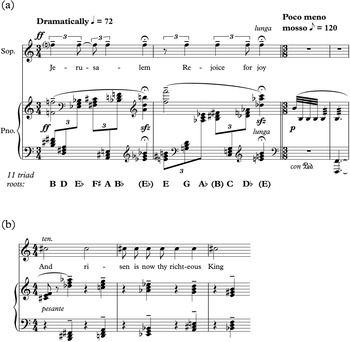
Example 4.1 Thea Musgrave, A Song for Christmas (1958): (a) triadic roots and hexachords; (b) triad streams converging on a focal B♭/E
Setting the William Dunbar text in A Song, Musgrave hews closely to the given poetic structure of verses and refrains. In the orchestral song cycle Triptych, likewise, she takes the patterned returns of the Chaucerian rondel poems “Merciles Beaute” as a cue for musical returns that brace the unfolding structure. Where A Song relies on spangled chordal brightness to evoke the Christian Nativity, Triptych spins transparent filigree textures from an orchestra rich in coloristic percussion. The shifting Klangfarbenmelodie at the start of Triptych (Example 4.2) offers a Webernesque emphasis on dyads; the richly scored tutti opening the second song, meanwhile, is a more characteristically Musgravian gesture. The importance of Webern's music for European composers of the later 1950s has been noted already, and Musgrave was certainly not immune (of the 1957 Robert Craft LP recordings, she recalls, “we all pounced on them”).Footnote 35
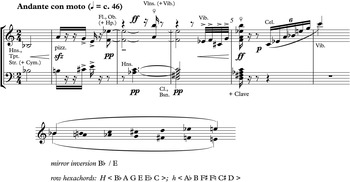
Example 4.2 Musgrave, Triptych (1959), Song 1, opening: mirror inversion and dyad pairs
The glittering percussion continuo in the third song of Triptych (Example 4.3 )– vibraphone, celesta, and bongos, with harp and pizzicato strings – led Porter to detect a Boulezian concern for “pretty instrumentation,”Footnote 36 but the widening timbral palette was not limited, in the 1950s, to the music of supposed radicals. The twinkling celesta writing in Dallapiccola's Cinque frammenti di Saffo (1942) – an image of moonlight and dreams – might have influenced Musgrave's scoring. Still, in capturing the tortured moods of Chaucer's courtly lover, did she also consider Stockhausen's Kreuzspiel (1951) – scoring for bongos – or the vibraphone role in Vaughan Williams's Eighth Symphony (1956) and Britten's The Prince of the Pagodas (1957)? The British sources are as characteristic of the period, in timbre, as Boulez's Marteau or Stravinsky's Agon, but the circulating discourse of stereotype insists that such instruments – initially associated with commercial music – are “foreign” imports. Satire confirms the attitude: the “Punkt Contrapunkt” sketch in Gerard Hoffnung's Interplanetary Festival concert (1958) had a sophisticated London crowd laughing at spoof-modernism (pointillist twelve-note melodies, vibraphone to the fore) by one Bruno Heinz Jaja, a fictional German composer (ghost-scored by Humphrey Searle). Hans Keller's infamous “Piotr Zak” hoax, broadcast three years later on BBC Radio, still conflated Darmstadt modernism with percussion-centric sound effects.Footnote 37
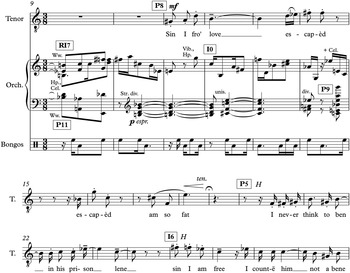
Example 4.3 Musgrave, Triptych, Song 3, opening: multiple row forms interwoven
The colors in Musgrave's Triptych are a more obvious sign of her modernist interests than her serial pitch choices, and memorable timbral chiaroscuro is crucial to creating the contrasting moods in each song. Song 2's somber-hued death march blends piano, harp and bass drum with strings, as an undertow to vocal outbursts of histrionic dejection. In Song 3, the scene shifts to an opulent sound canopy, setting the singer's escape from Love's snares (“Sin I fro’ love escapèd am so fat”)Footnote 38 into some strange and exotic realm. Fashionable or not, Triptych was warmly received at its premiere, at the 1960 Proms, and was among the first of Musgrave's works to be commercially recorded.Footnote 39 Making the most of an opportunity to be heard by a large British audience (the concert was also radio-broadcast live), Musgrave chose to present a work with an English text. Like Davies's First Taverner Fantasia (1962), her Triptych gestures musically to an inherited British national canon; like Maw in Scenes and Arias and Wood in Scenes From Comus (1965), Musgrave chose a non-contemporary style of love poetry, the strangeness of Chaucer's English lending a self-advertising historicity to the score. Her regional identity as a Scot was frequently noted by reviewers, though her first choices of texts balanced Scottish and early English sources.Footnote 40
The three poems in Triptych build form by textual repetitions: each is a rondel, with an initial three-line stanza 1 that returns – first partially, then complete – as a refrain to stanzas 2 and 3. Musgrave matches the refrains, and the extra binding force of end-rhymes, with easily recognizable musical returns. Such audible patterning stands at some remove from Darmstadt-style discussions of musical form. The post-war theoretic emphasis on structuring separate musical “parameters,” as Carl Dahlhaus observed at the time, elevated thinking about technique above traditional aesthetic conceptions of large-scale coherence; “form as an artefact” was disparaged.Footnote 41 Boulez's claims about a contradiction between serial technique and inherited formal principles in Schoenberg's serial oeuvre (as noted earlier) are no less characteristic.Footnote 42 As aesthetic manifestos on form specifically, though, such roundly critical effusions ultimately gained very little traction among Manchester-generation composers in Britain. Goehr's interest in variation emerges early in his oeuvre; refrain as a formal and dramatic principle is integral to the music of Birtwistle and Crosse. Musgrave herself was no less concerned, in Triptych, with building large-scale musical coherence from the “given” form of a chosen poetic source. For a composer of her basically dramatic sensibility, musical form emerges intuitively, as the projection of the poet's first-person subjectivity within a clearly felt refrain pattern.
“Your eyen two will slay me suddenly,” the singer's begins, in a bitter admission of his vulnerability to merciless beauty: the image of a pair of eyes is implicit already in the audible mirror-symmetries of Musgrave's orchestral introduction (Example 4.2). Fanning out from a strangely urgent B♭, the wedge shape reaches nervous release (“suddenly”) in a loud chord, so punctuating a gesture – quirky, but assertive – whose returns steer the song's progress. Musgrave spoke in 1960 of being surprised by “a far wider range of expression than she would ever have believed possible” in writing serially. Her statement reflects a common suspicion that employing twelve-tone rows might curb a composer's creative freedom, one voiced even among practicing serialists: “the walls in the rooms of my younger generation confrères … appeared to be lined with pages of pre-compositional diagrams, arrows in all directions, blocs sonores and other scaffolding for their contemplated musical edifices,” Elisabeth Lutyens wrote, recalling the mid-1950s.Footnote 43 The scientific tone of Die Reihe and other Darmstadt-circle publications furthered a 1950s image of serialism as high structuralism – even as French linguistic thinkers attacked serialists for failing to distinguish system (or langue) from individual utterances (parole).Footnote 44 Again, the intellectual debates counted less momentously in London than the artistic results of esteemed practitioners: the “freedom of constraint” Stravinsky had found with twelve-tone procedures by the 1950s was a compelling example for British composers anxious about the technical state of the art form.
Musgrave's opening wedge phrase, as serial technique, artfully mediates between row-derived pitch sequences and a composer's taste in how and when to repeat, accentuate, or move on. The hexachordal row that dominates Triptych (stated melodically in Example 4.3) plays a limited role in the opening of Example 4.2; the music's “logic” is one of dyadic mirroring. The initial wedge gesture, from B♭ to E (mm. 1–2), frames two dyads – (A, B), (G, C♯) – so completing a first hexachord, after which the “missing” dyads – (E♭, F), (A♭, C), and (D, F♯) – appear. The resonantly voiced accumulation of third, seventh, and ninth verticals in mm. 2–4 finds cadence with the “sudden” eight-pitch sonority of m. 5, gathering up the glittering play of previous measures. The celesta's closing flourish does trace the row's first hexachord (H), but its internal pitch detail – and that of the Klangfarbenmelodie that follows – eschews emphasis on the twelve-tone row as a fixed melodic ordering.
The most strict serial patterning in Triptych is also the most audible, for Musgrave pairs poetic refrains by mirror inversion: falling phrases are answered by ascents, melodic lines are retraced in precise retrogrades (Example 4.4(a)). The rondel refrains are a part of the form whose elegance a listener can admire; beyond that, Chaucer playfully permutes keywords within and between lines (“So woundeth it throughout my hertë keen(e),” line 3, leads to “My hertës woundë, while that it is green(e),” line 5). Musgrave, too, builds continuities and emphases by a comparably loose working of lexical units already in play. Vocal and instrumental returns of the motto-like opening phrase, presenting the row's H hexachord, are easily recognized. But the same hexachord, and its complementary pitches (h) also generate the activity of the song's climax by close-knit motivic interweaving (“ye ben of my life and death the Queene”: Example 4.4(b)). The surface teems with vertical and horizontal derivations of the row hexachord in several forms: familiar H pitches (starting on B♭), their retrograde, and a rising line (from C♯) that spells the remainder of the row, h. Scurrying string lines prolong a richly chromatic harmonic field loosely rooted on C, while in the winds, a sustained chordal wash (another, transposed, form of H) prolongs B as a harmonic root. This climax is borne of dense oppositions, but the underlying harmonic polarities have been well established already. After this, the song's last few bars create meaningful closure, harmonically and poetically, with one final vocal refrain. Musgrave's fade-out ending is her deliberate departure from Chaucer's scheme, for she has added two more iterations of line 1's last word, “suddenly.”
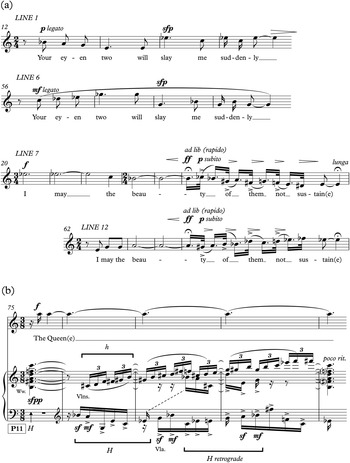
Example 4.4 Musgrave, Triptych, Song 1: (a) poetic refrains as mirror inversions; (b) overlay of row motives at the climax
Song 3 harbors a trap. As the singer revels in a fantasy of escape from Love's snares (“I never think to ben in his prison lene / Sin I am free, I countë him not a bene”), he does so within music stricter in construction than earlier in the cycle. One facet of his unwitting confinement is the dense gamelan-like percussion activity. Another is the ironic gulf between his verbal profession of freedom, and the tightly delimited intervallic make-up of the melodies by which he delivers the claim. His confidence at the poem's climax – “I do no fors [care], I speke right as I mene” – rings hollow; this lover is ultimately a fool to think he can truly spurn “merciles beaute.” The music spins an image of self-delusion by its audible symmetries of constructive rigor (see Example 4.3, above). Song 3 presents a complete twelve-note set directly as a melody (“Sin I fro’ love …”), followed immediately by a vocal phrase of self-evident circularity: the new hexachord statement (“I never think”) is answered by an inversion (“Sin I am free”), transposed so as to avoid introducing new pitches.Footnote 45 Meanwhile, every aspect of the accompaniment is saturated with related forms of this twelve-tone row, transposed as if to keep the singer's pitches (a P8 row) apart from his surroundings. Working within the self-imposed strictures of a twelve-tone row ordering, Musgrave's choices of pitch level sound with a cumulative force, as when the original motto-pitches of the first song (the H hexachord, <B♭ A E G E♭ C>) return in the first vibraphone phrase of the third, followed moments later by a chordal vertical that freezes the same pitches into one pillar of sound (strings, m. 5). That same mysterious floating sonority reappears in ghostly fashion at the end of the third song, and then Triptych fades, suddenly, to nothing.
Musgrave's serial phase, albeit situated quite early in her long professional career, produced works of mature artistry, individuality, and formidable craft. Still, there was often a note of caution in critical responses. Musgrave's oeuvre has been described as representing, as Stephen Walsh puts it, a “via media of British music: a tempering of strict orthodoxy with an instinctive moderation which also disposed her against experiment with any more outré forms of the avant garde. The tone of her music was serious but not solemn, its personality somewhat retiring.”Footnote 46 Walsh touches in passing on the common trope of British stylistic “reserve,” sketching a historical précis recalling Porter's sense of “Darmstadt fashions never acclimatized” to British soil; Walsh aptly notes Musgrave's tone of voice, but his sense of a “retiring” personality is harder to square with music of such vehement thematic delivery: the forceful pronouncements that frame the Monologue for solo piano, the group-contrapuntal animation of the Serenade, or the deftly etched scenes comprising Triptych. In each, one hears sharply characterized musical role-playing – a feature of Musgrave's art that was to intensify during the 1960s.
Musgrave has never complained publicly of professional neglect, and she launched her career quickly by fulfilling a string of early commissions. Her professional success defied the gender stereotypes of the day, enshrined in the demeanor of some 1960s press notices: “Miss Musgrave herself is Scottish and feminine, but preconceptions about her music on these counts are flatly contradicted by the Sinfonia which is neither dour nor prettily decorative.”Footnote 47 Yet she remains one of a tiny group of female composers discussed in the present book; British musical modernism as a compositional endeavor was – like its Darmstadt and Parisian counterparts – invariably a man's world, though, without an emerging generation of talented female performers, it would probably have achieved nothing.
Musgrave's stylistic evolution after Triptych was rapid. In Monologue and Colloquy, she moved a step closer to the boldly dramatic scenarios of her “abstract-instrumental” concertos of the mid-1960s. Her commitment to a plain-spoken thematic texture set her music apart from 1950s pointillism (the orchestral filigree of the third song in Triptych is as close as she gets to the intricate orchestral surfaces of Davies's Prolation.) And her interest in conventional fugal imitation – in Monologue and the Serenade, for instance – appears equally remote from Darmstadt-circle aesthetics. Whether imitative counterpoint was a relic of Boulanger's influence or not, Musgrave's neoclassicism aligns her with Goehr, another composer happy to use conventional repeat signs and da capo returns in his music (as in his Suite, Op. 11, commissioned, like Musgrave's, for the Melos Ensemble). Musgrave's slight seniority within the Manchester generation (she was four years older than Goehr, nine years older than Crosse), may have encouraged her to cultivate a greater distance from the Darmstadt scene than other, younger, Manchester-generation figures. Her modernism engages tradition without any noticeable opposition to inherited musical discourses. Musgrave's abandonment of twelve-tone writing after about 1961 was relatively abrupt, and final. In an interview, she cites a skeptically phrased remark of Glock's (ca. 1962) – “You're not going to write serially any more; then you really have to invent” – as one that stuck in her mind.Footnote 48 Her early serial period was fruitful but finite, a time of conscious experiment with technique. In Musgrave's own words, it was “a great discipline.”
Avant-garde and beyond: Nicholas Maw's Scenes and Arias (1962)
For about five years or so concertgoers have been retailing, with many a rolled eye and bated breath, the erotic wonders of a piece called Scenes and Arias which Nicholas Maw composed for the 1962 Proms.
Belated public recognition of Maw's Scenes and Arias as some kind of turning point for British music speaks to a sense of release from the historically and stylistically defined pressures of avant-garde writing in the early 1960s. Maw dared to revisit, unapologetically, the luxuriant orchestral textures of German romanticism as the backdrop to love-music of special intensity. Hushed references to “erotic wonders” do not crowd the press notices of the post-war avant-garde – attention to technique (serial technique, that is) was the order of the day, with lively prejudices against a music of overt emotional subjectivity. Maw's romanticism, equally, embraced a kind of vocal writing that “one had thought was a closed book to composers of his generation” (as Donald Mitchell wrote of the premiere).Footnote 49 Maw's lyric “effulgence” (to recall his own words)Footnote 50 matched the Rousseauian idea of poetry as archaic, spontaneous expression; mid-twentieth-century musical modernism, however, though it did engage avant-garde poetic forebears (as in Boulez's Marteau or Davies's Revelation and Fall), favored the depersonalized voice of Surrealist dream or Expressionist nightmare, building on a literary inheritance of mimetic ambiguity, rather than the autonomous consciousness of Romantic verse.Footnote 51 Maw's piece was “unusually passionate,” Walsh later wrote, “for a work by a modern composer who had been through the serial mill.” For Bayan Northcott, too, Scenes was above all “unexpected”: Maw had broken the impasse marked by the confrontation of “serial law” with an “English succession” of Tippett and Britten.Footnote 52
To Maw himself, Scenes did “feel like a breakthrough,” though its wider import was to emerge only gradually.Footnote 53 The actual reviews, in 1962, were few and fairly mixed.Footnote 54 Like many cult pieces (especially orchestral works), Scenes forged a reputation without performances. Maw significantly revised his score in 1965–66, and this version was performed in March 1968 (the occasion for William Mann's “erotic” notice, cited above) and commercially recorded later that year.Footnote 55 But the breakthrough narrative remains emblematic chronologically of a loosening, among the Manchester generation, of allegiances to an “abrasive” modernism as a language of atonal pitch relations.Footnote 56 It was at this moment that Musgrave took her leave of strict serial writing, and for Maw, 1962 marked a stylistic arrival after an arduous search during the preceding five years.
Maw's stylistic move from the clear linear textures of the Flute Sonatina (completed in 1957, while at the RAM) to the more angular expression of the Chinese Songs (written mostly in Paris in Fall 1959) was, in a “post-Webern” context, hardly unusual. His other major score of 1957, the Nocturne for mezzo soprano and orchestra, explores weighty chromatic curtains of string sound and bird-song-like woodwind arabesques. While the synthesis is not entirely distinctive (the composer was 22 years old), its intricate formal palindromes and mirror-symmetric inversions do not sound mechanical.Footnote 57 That Maw quickly published the Sonatina (Example 4.5) but withdrew the Songs (see Example 4.6), even after successful Cheltenham and SPNM performances, suggests the stylistic and technical ferment of his early twenties.Footnote 58

Example 4.5 Maw, Flute Sonatina (1957), first movement opening
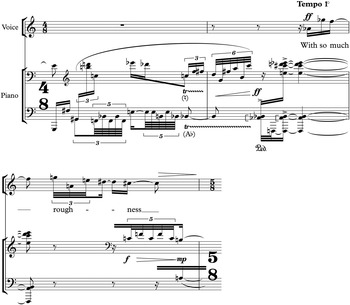
Example 4.6 Maw, Six Chinese Songs, No. 1 (1959), excerpt
The crisply melodic Sonatina, even with its orderly play of row-derived tetrachords, is stylistically not far from the etched neoclassicism of Maw's RAM teacher, Lennox Berkeley; the Chinese Songs, on the other hand, were a direct fruit of his studies in Paris with Max Deutsch. If their new rhythmic intricacy has a touch of Darmstadt, they were (according to the composer) a conscious attempt to achieve clear and virtuosic writing for both voice and piano, and “to write with extreme harmonic consciousness.”Footnote 59 Maw had found Deutsch's analyses of Strauss's Elektra particularly enlightening, and much later on cited the German composer's focus on distinctive chord types (“along the cliff-edge between tonality and atonality”) a suggestive model for the harmonic world of Scenes.Footnote 60
Maw was well aware of recent developments, too – in 1962 he published a short admiring essay on Boulez's music – but his own music was moving chronologically backwards, finding its musical roots in pre-1914 modernism.Footnote 61 One more work, the Essay for organ (1961), drew on a proto-serial intervallic scheme (a ten-note pitch row), but it was in Scenes and Arias that Maw, as Anthony Payne observed, reached a “post-expressionist” language.Footnote 62 Besides the glittering orchestral sonorities and the sumptuous vocal writing for three female voices, it was Maw's chromatic but tonally allusive idiom that drew the critics’ attention. Scenes had an operatic scale to it, and Maw was soon fulfilling operatic commissions. His musical development during the 1960s was as closely watched – and written about – as that of any of his colleagues.Footnote 63
Much of the excitement, as already hinted, concerns Maw's reanimation of a lyric sensibility within a chromatic pitch language that could communicate passionate human feeling to audiences. The chosen text in Scenes was a medieval love poem in two parts, a man's appeal to his beloved (“De Amico ad Amicam”) and her loving reply (“Responcio”). Maw keeps the original text's two-part division as a formal scheme, while avoiding entirely the possibility of casting soloists as characters (a male and female singer, say). Instead, his soprano, mezzo, and contralto sing at times as a collectivity, elsewhere as soloists, their utterances supported by finely layered orchestral settings, and framed by untexted orchestral interludes. Behind the music's evident intensity lies a rhetorical subtlety and psychological complexity that bear closer consideration.
Operatic rhetoric
Maw's chosen text interweaves medieval English with French and Latin in a consistent pattern. The first verse sets the scheme of the whole poem: paired three-line sequences, each a French-English couplet followed by a brief Latin refrain. Within couplets, French lines precede English, the two tongues bound by end-rhyme.Footnote 64
The Latin words also rhyme final vowels, binding the two halves of each verse. The poem moves by continuous discursive shifts, as if each change of language signals a change of speaker, or else the blending of three voices in one shared speech. The first line identifies itself as the opening of an epistolary exchange (“A celuy que”; To her who): these are love poems, secret missives replete with coy verbal games meant only for the beloved. A result of the stanzaic patterning is that individual lines of verse stand alone, syntactically speaking, with minimal sense of an evolving narrative. As a sequence of self-contained love vows, the poem amounts to a litany of unbroken emotional revelation.
Writing Scenes consciously as a study for work on an opera, Maw envisioned “a kind of shadowy, hypothetical action,”Footnote 65 and his score is not text-driven in any simple sense. A poem rich in fragments and in internal breaks gives cues for an essentially musical continuity, comprising shared vocal-orchestral “scenes” and “arias.” The loose plurals of Maw's title identify musical events of an emotional-affective nature, surges of feeling rather than the movements of some physical plot.
Maw's musical translation of the poetic rhetoric opens with a carpet of orchestral sound, hushed but ecstatic (Example 4.7 shows the opening bars), over which the solo soprano, on a high B, floats in.Footnote 66 The languorous melismas of line 1, drawing out elements of the orchestra's static but quivering pedal sonority, gives way to a contrasting chordal mass, as line 2 arrives. A third harmonic shift (at m. 9) announces the advent of the mezzo and contralto voices with the first Latin word. Apart from the advent of the vocal trio, this discursive-linguistic shift registers rhetorically in a turn to clear syllabic delivery, in tender repetitions of the single-word endearment, “Carissima.”
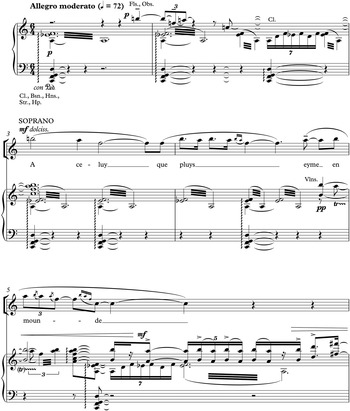
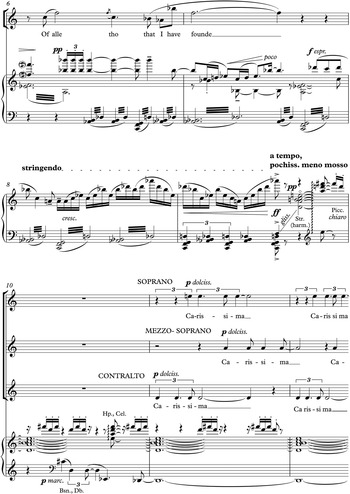
Example 4.7 Maw, Scenes and Arias (1962, rev. 1966): vocal-orchestral intimacy at the opening
Voices and orchestra at the opening are in a state of intimacy. The singers do not assert much independence of their sonic environment, furthering an impression of shared powers of musical utterance. The soprano emerges from a hazy shimmer of woodwind pitches, her falling line (B–A–F–C) quickly echoed in trill figures, a motto-like gesture answered in free inversion by the violins (A–B–D–F♯, mm. 4–5). The thrilling multiplication of speaking presence at “Carissima” repositions voices and instruments, as a diffuse, ornate texture yields to a calm pedal sonority – brightly lit by string harmonics with a piccolo fragment twinkling overhead.
Voice-orchestral intimacy defines a fluid speaking presence, at times suggesting the singular poetic “I,” elsewhere dispersing grammatical constructs in purely melodic instrumental arabesque. In his early Nocturne, Maw had adopted a declamatory lyricism (redolent of Britten's Serenade) with a solo voice at center-stage, and instrumental illustration of discrete poetic images, but the poetry of Scenes is not so figurative, and Maw's orchestra does not go in for word painting. For all Maw's well-known interest in pre-1914 models, his imaginative approach to text in Scenes has affinities with certain Darmstadt-era works – Boulez's Marteau, with its instrumental “doubles” of texted movements, or Nono's phonetic fragmentation of words in Il canto sospeso.Footnote 67 Maw has affirmed that Strauss was a conscious model for Scenes, specifically in crafting a harmonic language of intervallically distinctive chord types. Analysis confirms that Maw's three opening harmonies (setting lines 1–3 of the poem) traverse a fully chromatic pitch aggregate,Footnote 68 but it is the suggestive physicality of the move that conjures Straussian stagecraft most directly. Tingling anticipation gives way to a heaving back-and-forth motion, reaching a sudden high-pitched climax. The impulsive passion of such a gesture, repeated twice in a row, mimics sexual release, but London critics – even recalling the notorious failure of the obscenity charges brought against Lawrence's Lady Chatterley two years earlier – may have preferred not to say so in 1962. Northcott later wrote of “orgiastic energy” in Maw's Part II interludes,Footnote 69 and worldly twenty-first-century listeners might grant Maw's score a frankly physical eroticism more acceptable in opera houses.
Voices and arias
Maw's oeuvre is rich in psychological allusion. Even in instrumental scores, his choices of title (Life Studies or Personae, for example) encourage listeners to equate harmonic and textural density with the layered workings of consciousness. Maw's female protagonists often confront some buried past, as in the 1966 song cycle The Voice of Love, depicting a youthful love affair, treated in flashback, within a Prologue-Epilogue frame. The lovers’ passions in Scenes and Arias are far from retrospective, but they voice painful separation (“Woulde God in youre armes I were”), so that erotic union, in effect, is achieved as an imagined musical unity of themes within the polyphonic orchestral flux. Vocally, too, the varying trysting of the three female singers constructs a speaking presence of mutable psychological detail.
The five verses of Part 1 offer distinctive vocal presences. In Verse 1, as seen earlier, the soprano's first outpouring is answered by the imitative union of the trio's Latin refrain. In Verse 2, the two higher voices playfully bounce phrases back and forth in a shared traversal of the words in scintillating dialogue with an orchestral scherzo.Footnote 70 Only in Verse 3 does a solo voice, that of the dreamy contralto, command the stage, lapsing into wordless vocalise absent in the original poem. Verse 4 is a reprise of Verse 1's dialogic scheme (now with the mezzo as soloist), leading into the more elaborately proportioned Verse 5. This unfolds slowly as fugato, each voice contributing a Subject entry in a steady registral ascent from the contralto's low G to the soprano's climactic top C♯. A subsequent stretto-like overlap, reversing course (high to low), draws the three soloists into still closer imitative exchange, until (“Valete”) they coalesce into rhythmic unison as a trio. In place of a Jamesian “center” of consciousness, Maw elaborates a fissured multiplicity, trailing clouds of philosophical significance. Scenes evokes twinned Cartesian intuitions – the metaphysical difference of mind and body, and the undefined intimacy of a signature experience of self – and does so by engaging the spectacular orality of opera, the medium par excellence of ecstasy and self-reflection.Footnote 71
The five versions of the lover-poet offered by Maw's vocal trystings are tethered to an orchestra capable of intimate support or opulent extension of lyric song. The transition in Verse 3 from the contralto's “Requiro” to an orchestral interlude exemplifies the shared vocal-instrumental point of view (Example 4.8). Her wordless reverie smooths the seamless passage from texted song to instrumental counterpoint: her low G♯ takes over from the alto flute's trill; the brass chorale phrase picks up where she leaves off. While the melodic continuity appears unbroken, the scene is shifting harmonically. The contralto's song is an outgrowth of the trombones’ C♯-minor triad, a static low-register tonal stratum. Above it float polychordal higher colorations, in the kind of terraced disposition of chromatic pitches that is so distinctively Maw's own. The string chords, sul ponticello and muted, maintain timbral separation, while projecting the telling return of the first two chords of the piece. Transposed from bass to treble register, the harmonies sound novel, but their local effect is equally to subtly destabilize the trombones’ C♯-minor triad as a tonic. Maw's bass creeps down smoothly from C♯ to C (another leitmotivic echo of the opening); the brass chorale is densely chromatic (seven, six, and six pitch-classes, respectively, at R15), casting dusky light on a new phase of the drama. Thematically, the four-note turning shape (G–F♯–D–E in solo viola, and taken up in the brass) echoes, while extending, the soprano's commanding entrance at the opening (originally, B–A–F). The transformed motive will make a prominent return in Part 2.
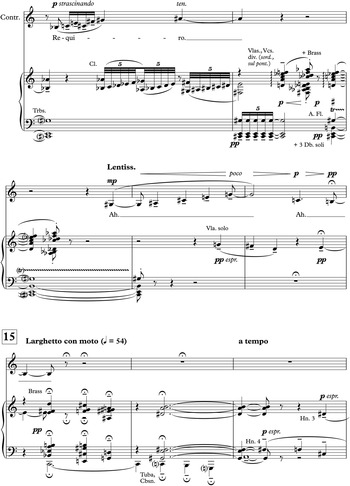
Example 4.8 Maw, Scenes and Arias, “Requiro” as transition to an orchestral interlude
Orchestral scenes
Maw took from Deutsch's Strauss analyses both specific harmonic insights and a broader awareness of late-Romantic rhetoric. The forceful dramatic progress in Part 2 of Scenes includes weighty tuttis, but these are set off by more soloistic chamber scoring, as close to Mahler, Schoenberg, or Berg as to Strauss per se. Even so, the full-brass chords and frequent division of strings in Scenes unapologetically evoke nineteenth-century colors, in ways that Musgrave's percussion-rich Triptych or Goehr's soloistic Little Symphony do not. The diffuse figuration opening Scenes is a matter of sub-thematic details (the clarinet septuplet of m. 2, say) that quickly surface then recede into the sonic mass. Melodic motives emerge with varying degrees of emphasis; Maw's comment on Boulez's Marteau (“Elements are introduced, mingled and built up until finally a statement is made”) well describes the self-generating thematic continuities – a play of variants and cross references – in Scenes itself.Footnote 72
A case in point is the little turning shape setting the soprano's word “Incisto” near the end of verse 2 (at R7). The idea slips in fairly unobtrusively (murmured also by cor anglais and solo viola, a fifth lower), returning twice as a fleeting parenthesis amid the onward rush of the following scherzo.Footnote 73 Reappearing more prominently, this Incisto motive generates string counterpoint in the Part 1 interlude (at R16), yet even here, the listening experience is of dawning familiarity, not outright recognition. A comparable motivic fluidity governs the many forms of a quivering repeating-note idea first heard in Verse 3 (see flute and string figures, R12). This complex of ideas is essentially rhythmic, an involuntary shiver (aptly marked inquieto in the flutes). The essential balance, throughout Scenes, is between an evolving long-range coherence and what Arnold Whittall terms the “proliferation of ‘free’ detail.”Footnote 74 With the Incisto and Inquieto ideas, among others, Scenes accrues motivic connections surreptitiously, reserving more assertive gestures – self-evident returns – for overarching architectonic effect.
Momentous formal correspondences in Scenes are made in the related orchestral passages that end each part of the half-hour span. In both cases, the soprano's ecstatic Part 1 entrance music is recollected in orchestral tranquillity. Near the end of the passionate epilogue to Part 1 (two bars before R26), the violins’ “declamando” arrival on the soprano's high B's initiates a wordless cantilena that descends gradually in an elegantly arching close. It is among the few passages in Scenes offering a plain melody with accompaniment texture, all other activity subsidiary to the string line. Formally, there is an obvious rounding here, though the return of vocal music in an orchestral “singing” carries a sense of human presence, still. That impression is secured by the shocking contrast of the orchestral music that follows (see Example 4.9). In pointillist fragmentation, by a saturation of mechanically chattering ostinati, the texture evacuates the earlier singing subject. It is a kind of Bergian curtain-music, the lowering of a glittering scrim on earlier melodic presences.Footnote 75 Maw has woven the Incisto figure into the texture, hidden in the softest string harmonics (the B♭, in m. 3 of the excerpt, begins this shrouded whisper). But the scene is a blank, its anxious coolness produced by a sudden loss of tonal focus. The paradoxical feeling of emptiness, in so busy a texture, has been triggered once again (shades of “Requiro”) by a chromatic bass descent, clouded – in the lowest register – by encroaching atonal clustering.
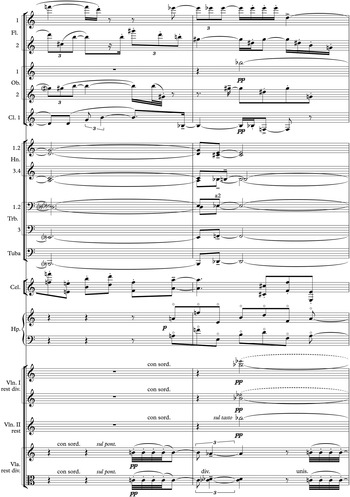
Example 4.9 Maw, Scenes, Part I, orchestral curtain-music
The sense of an ending, at the close of Part 2, will involve further prominent returns to the soprano's ecstatic Part 1 entrance-music. The distance we travel, emotionally, can be measured in the contrast between the rough orchestral “breathing” of the interlude mid-way through (rapid hairpin crescendi, tutti, at R42) and the absolute calm of the closing Andante. Maw returns, in these last few pages, to near-literal repetition of the opening scoring, with further sonic distance (the horns are muted now) and the telling substitution of a solo oboe for the soprano voice. A passacaglia-like sequence (R47–52) roves systematically, as Payne notes, through eleven transpositions of its theme.Footnote 76 The theme inverts the earlier turning shape, newly recalled by a solo horn (R47).
A passacaglia is hardly unusual as a choice for finale-rhetoric, but in Maw's case, the formal rigor of the procedure seems symptomatic of the stylistic-technical challenges he had faced prior to composing Scenes. Like a slightly older contemporary, the German Hans Werner Henze, Maw in the 1950s and early 1960s moved from active engagement with the technique-consciousness of the avant-garde to a stylistic position that could accommodate elements of late-Romantic melodic and orchestral traditions. This musical past was again open to exploration or belated evocation (Robin Holloway, by the later 1960s, would take a historically explicit style much further, into the realm of direct quotation). For Maw, in Scenes and Arias, the break with avant-garde dogma, when it came, was less an outright rejection of the terms of the debate than a natural and necessary assertion of artistic independence. His music in Scenes and after (like that of his Manchester-generation colleagues) was, in its reliance on the norm of a fully chromatic pitch vocabulary, recognizably a product of the post-war stylistic ferment. But Darmstadt had, in his own words, “rejected too much of the past for my temperament,”Footnote 77 and in Scenes, finally, Maw's artistic temperament won out.
Lyricism and rigor: Gordon Crosse
… it was my intention to capture, in the expression and technique of the present, some of the unique synthesis of fragrant lyricism with intellectual rigour which is the feature of Medieval French art.
The very public success of Gordon Crosse's children's cantata Meet My Folks! at the 1964 Aldeburgh Festival was followed by a steady stream of commissions and ongoing critical attention. A new score for children, Ahmet the Woodseller, was seen on television in 1965 as a BBC schools broadcast; for adults, too, there was a TV broadcast: the one-act opera Purgatory – jointly commissioned by the BBC and Cheltenham – premiered in July 1966. With “educational” works and a track record of communicating with a broad audience, Crosse was welcomed as that rare animal, an artist of avant-garde pedigree with broader popular appeal (a comparable image was formed of Bennett). Crosse had established personal contact with Davies in the later 1950s, having admired the slightly older composer's early sextet Alma Redemptoris Mater.Footnote 78 During his undergraduate years at Oxford (1958–61), Crosse was busy with incidental music (even scoring a musical farce), alongside academic studies, and after gaining a First he stayed on for two years’ post-graduate research on fifteenth-century music.Footnote 79 Davies's synthesis of medieval isorhythm with a thoroughly post-war pitch technique was a compelling early model for Crosse, initially, but his stylistic outlook was above all eclectic.Footnote 80 The basically tonal melodic style of Meet My Folks! was furthered in Changes (1965), a large-scale choral-orchestral cycle for the Three Choirs Festival, and with Crosse's evident interest in writing works for non-specialist audiences, the obvious and much-cited comparison was to Britten (whose 1962 War Requiem had reached a broader audience than even his operas).
Crosse's eclectic aesthetic preoccupations were already in place by Fall 1959, when he produced the first works he acknowledges (later published as his Op. 1, 2, and 3). His note on the Op. 2 Villanelles score affirms a “technique of the present” as the medium for exploring forms and feelings he associated with the medieval. Another discovery from these years – of Webern's music – left its imprint on the intricate play of tiny melodic fragments among the seven players in Villanelles. Crosse takes his material from an anonymous thirteenth-century chanson, though the melody itself is frequently disguised: in No. 4, for example, the diatonic cell G A B and its inversion/retrograde D C B♭ are stretched by wide seventh or ninth leaps. The resulting filigree of isolated and variegated attacks recalls Davies's Alma as much as Webern, though tell-tale Crosse fingerprints – loosely aligned fluttering ostinati, for example – are already prominent.
“We're all slightly defensive about technique,” Crosse later said,Footnote 81 a remark that would seem to reference British modernists of his own generation; it will be no surprise to discover in his earliest scores – including the Elegy, to be discussed shortly – a grappling with various kinds of serial workings. But there is room, equally, to acknowledge facets of his artistic personality that transcend phrase-level constructive detail. As with Musgrave and Maw, the music's tone and characteristic moods draw the listener. In Crosse's case, the compositional voice owes something to the distanced formality in Stravinsky, to whom he ascribed a “re-creation of a religious and functional art of music after the egotistical expressive crisis of the nineteenth century.”Footnote 82 For all Crosse's interests in bold mimetic effects – the many bell-sounds in Changes, for example – his music often finds its way to states of contemplation or the uncanny; his work often has about it the necessary mystery of a ritual.
Crosse would later – in the early 1970s – express reservations about the more tuneful side of Changes (“It woos people a little too much. It's a most dangerous thing to do to sit down and say ‘I will write a popular piece’”).Footnote 83 His anxieties about “audience” are emblematic of an increasingly fragmented post-war cultural hierarchy, and of the difficulty of defining a language accessible to a listening public (Britten's reputation as a “communicator” was discussed often in the 1960s, precisely because communication seemed increasingly difficult). Even so, Crosse's sophisticated craft was not, in practice, incompatible with the possibility of wooing audiences. There is a certain consistency in his compositional technique, whether writing for virtuosi or for untrained children. Notes for a 1967 recording of the Concerto da Camera, Op. 6, include the composer's detailed comments on serial row derivations (complete with music examples). The same mode of structuralism, fashionable at the time in art-music circles,Footnote 84 accompanies Meet My Folks!, albeit in the more apologetic tones of a liner note addressed to teachers (twelve-tone rows are “primarily the composer's business, but it is interesting for a listener to know what gives a work its flavour”).Footnote 85 The music itself, meanwhile, speaks unpretentiously to the children, giving prominence to a “percussion band” of glockenspiels, xylophones, bells and drums, alongside a small professional ensemble (a note in the score advises that “the children should preferably have ‘Orff’ instruments … but other instruments may be substituted or added ad lib”). In the companion piece, Ahmet the Woodseller, the children's unison melodies and percussion parts were printed in a simple-format score (attractively adorned with two-color linocut drawings by John Griffiths), published and distributed by the BBC.Footnote 86
Davies and Birtwistle had taught full-time in secondary schools, while Crosse's early teaching experience was at the university level; a picture of Crosse visiting Davies at Cirencester Grammar school in 1962 accompanies a later profile, and his activity as a composer of educational music continued longer than that of his colleagues.Footnote 87 That art-music composers of the 1960s sensed an ever-widening gap between traditional concert life and the recording-dominated world of pop-rock music is beyond question. Crosse, early on, was among those seeking to avoid too stark a division in the cultural hierarchy. In the 1960s climate of (as the Observer had it) “Two Worlds of Music,”Footnote 88 Crosse's concerns about reaching an audience without artistic compromise cannot be dismissed lightly. Yet looking back on Changes from a still later perspective (in 2007), his old worries about the score's directness are gone: “My chief conscious aim … was to fashion something enjoyable to listener and performer alike … I threw technical experiment overboard (but on a long rope – dangerous to forget it for long!) and concentrated on opening my ears and mind to simple ideas.”Footnote 89 Again the specter of technique looms large in his recollection of the mid-1960s climate of opinion. For a composer with affinities for the “lyric” as well as for the “intellectual,” the changing cultural situation of the day posed challenges, but also opportunities.
In the serial workshop: Elegy, Op. 1
Crosse's official Op. 1, the compact and contrapuntally vigorous Elegy for small orchestra, offers one of the stricter essays in adhering to a “Classical” serial technique among the Manchester generation. Crosse uses a twelve-tone row from a Webern sketch, one he had found in liner notes to Craft's influential Complete Works LPs.Footnote 90 Even with so direct a modeling of pitch materials, though, the Elegy speaks clearly in its own passionate voice, free of second-hand gestural borrowings. That danger, so real in the 1950s, is underlined by Crosse himself in an early program note: “The ‘pointillistic’ orchestration of much Webern-inspired music has been avoided in favour of longer, contrapuntal, ‘singing’ lines … more suitable to the elegiac character of the music.”Footnote 91 A tentative and delicate opening (Example 4.10) leads to more assertive brass signals, moving to a tense climax, no sooner reached than abruptly abandoned, to make way for a veiled calmo passage, soloistic and muted. The dramatic journey is rounded out by a nocturnal “Cadenza” for loosely synchronized woodwinds, prefacing a brief but telling coda. An early version of the Elegy, scored for winds alone, dates back to Crosse's undergraduate years (the published score is inscribed “Oxford 1959–60”) but it was revised and first heard publicly at a 1962 SPNM concert.Footnote 92
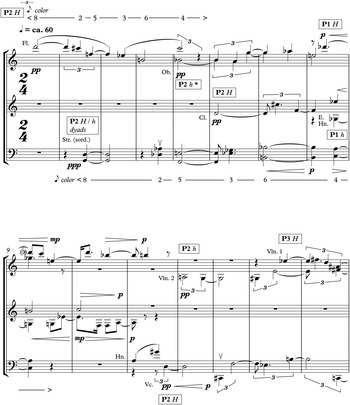
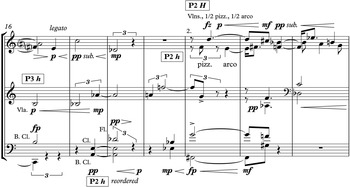
Example 4.10 Gordon Crosse, Elegy, Op. 1 (1959–60, rev. 1961), opening row forms and isorhythms
To observe in the Elegy a taste for unmediated dramatic contrasts – moving quickly from restrained intimation to impassioned outbursts – is not to ignore Crosse's more general debt to the quietism of the “post-Webern” aesthetic (Goehr's Fantasies, Op. 3, are even more restrained, for example). Crosse has the flute's opening phrase tip-toe in delicately out of silence, with careful timbral dovetailing between phrases (the cor anglais cadence note, A, passing from horn to violin at mm. 11–12). The overall tendency toward widely arching melodic leaps aligns Crosse with 1950s avant-garde accents, to be sure, but the harmonic sense is more personal, as when a fleeting A minor triad brightens, tierce de Picardie-like, to a no less fleeting A major (mm. 17–18). Fastidious dynamic sculpting of the violin melody at this moment – each note within the E C D♭ trichord set off from its neighbor by dynamic contrast – gives evidence of Crosse's awareness of the early Davies scores, and there are affinities between the Elegy's bold trumpet writing and, say, Davies's St. Michael. Even so, more precise assertions of “influence” may be tempered by chronology: the Elegy was complete by 1961, so its concluding wind cadenzas ante-date the recitative flourishes in Davies's better-known First Taverner Fantasia.
While the European cult around Webern's music peaked with the 1955 memorial volume of Die Reihe, his symbolic stature lingered awhile. The Austrian was an absent father-figure for younger composers at odds with the pre-1945 order of things, a “threshold” (Boulez) or “yardstick” (Stockhausen) for stylistic-technical advance.Footnote 93 The popular notion of a Darmstadt “school,” as Martin Iddon observes, itself originated in press coverage of the Webern 70th-anniversary events at the 1953 Ferienkurse.Footnote 94 Crosse, a 16-year-old schoolboy at the time, was working in what one commentator dubbed “a quintessentially English modal style,” moving quickly on to territory “somewhere between Bartók and Fricker.”Footnote 95 Stockhausen, meanwhile, had analyzed permutational groups of pitch, duration and dynamics in the Konzert, Op. 24, asserting a “Darmstadt” Webern, antecedent of the parametric techniques of elektronische Musik.Footnote 96 Electronic music had barely penetrated British modernist circles in the 1950s, and the British view of Webern, unsurprisingly, was very different from Stockhausen's. Humphrey Searle, for one, rejected Stockhausen's permutational analysis specifically (“Webern used the series in a purely ‘classical’ way, and never went in for mathematical procedures of that kind”).Footnote 97 It is likely that Crosse's interest in Webern was informed by his personal contacts, while at Oxford, with Egon Wellesz (who had known him in Vienna when both were studying with Schoenberg).Footnote 98 And while Webern did not serialize durations in his music, he had found in Flemish polyphony (on which he had presented a doctorate) a model for the considerable canonic rigor of his own textures. Crosse's fifteenth-century interests, meanwhile, led him to translate medieval techniques quite directly into his early published compositions. With an organized deployment of isorhythm, Crosse was wedding the strict derivation of pitch hexachords to no less strictly repeating durational patterns.
The pitch-row forms opening the Elegy (see again Example 4.10) are tied to varying realizations of a schema of durations, a talea in the proportions < 8:2:5:3:6:4 >. The cycle, with its opening agogic emphasis, is stated first as multiples of triplet-eighths in the flute (m. 1), and in the oboe, clarinet and violin entrances (mm. 5, 6, 14). A faster cyclic iteration, in sixteenth multiples, drives later flute and violin entrances (mm. 8, 20).Footnote 99 Accompanying this opening accumulation of imitative polyphonic voices is a slower-moving dyad layer, reiterating the same < 8 2 5 3 6 4 > cycle in eighth-note multiples.
With successive entrances repeating one durational sequence, rhythmic variety is a matter of subtle adjustments to the underlying counting unit, resulting in a fluid metamorphosis of attack speeds within melodic lines. The 3:4 ratio between the speed of the flute's opening phrase from D and its transposed near-repeat from D♭ (mm. 8 ff.) effects a subtle speed-up of pulse, a progression that is repeated in the string entries (mm. 13–20). The section is rounded out in the brass by return to the initial triplet-eighth unit (trumpet, m. 25), juxtaposed with its diminution (halving durations to triplet sixteenths), with a gradual ritenuto to underline the cadence rhetorically. Already at the opening, Crosse incorporates order rotations within the second hexachord of the underlying pitch row (marked as h in Example 4.11). In the next main section of Elegy (see Example 4.12), a familiar 3:4 ratio between beat speeds obtains in a stretto-like pairing of Subject and Answer entries, in still more nimble triplet sixteenth/thirty-second-note multiples. By this point, Crosse begins manipulating the internal ordering of both pitch and duration rows by a technique of rotation: the first two entries juxtapose the < 8 2 5 3 6 4 > cycle with its three-place rotation to < 3 6 4 8 2 5 >, effectively exchanging component trichords (in the clarinet entry, the rotation is one place less, generating a new rhythmic-melodic shape).Footnote 100 So this is strict serial music – a pre-ordained template generates local pitch and duration choices – but it is also “free” in its invention, far from the popular cliché of a mechanical process of row composition. And the composer can and does break his own rules, for example by rotating pitches but not durations (see the oboe entry, m. 5).
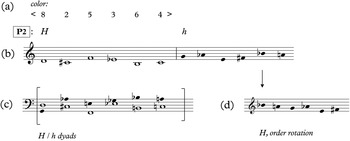
Example 4.11 Crosse, Elegy: structuring the row hexachords: rhythmic, harmonic, and melodic detail
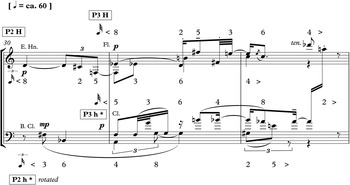
Example 4.12 Crosse, Elegy, second section opening: rotations of pitch and duration
Employing a rhythmic cycle, besides ensuring a certain structural consistency, allows Crosse to create a musical time-flow more akin to that in medieval-Renaissance polyphony, with little audible sense of the periodic accents of Classical-Romantic “bars.” Davies had used Indian rhythmic patterns (tala) in Stedman Doubles (1955), a comparable retreat from the European mainstream, with Messiaen's music an increasingly familiar model for British composers interested in such a synthesis.Footnote 101 Closer to home, the Anglo-Indian composer John Mayer (1930–2004) – having trained in his native Calcutta, then in London at the RAM, and as a composition student of Mátyás Seiber's – was introducing an explicitly North Indian-themed rhythmic language to progressive London audiences. His Raga Music for solo clarinet was heard on the same 1959 SPNM recital as Birtwistle's Précis I; by 1962, in notes to his Sonata for Violin and Piano, Mayer described “two serial techniques – the 12 note system and the Indian Raga system.”Footnote 102 The British modernist engagement with Hindustani music coincides with the international celebrity of the sitar virtuoso Ravi Shankar (who first visited London in 1956), and precedes by a decade the well-known interests of pop musicians such as the Beatles. Anthony Gilbert's Sonata No. 2 for Piano (Four Hands) of 1967 was the first of many works in which he incorporates “technical, though never stylistic” features of the North Indian classical tradition (at a moment when George Harrison's sitar performance on Sgt. Pepper's Lonely Hearts Club Band does almost the reverse).Footnote 103 Accustomed as music historians are to thinking British modernism first and foremost in terms of European encounters – responses to Darmstadt or “Viennese” models – there is room to acknowledge a wider, global play of influences.
Crosse's isorhythmic techniques in the Elegy are the work of a composer of eclectic techniques and temperament. The chamber-orchestral scoring, however dramatic in its shifting colors, gives few hints of his taste for percussion sonorities, soon to emerge in the Concerto da Camera, completed in 1962. The Elegy, meanwhile, is the work of a musician traveling in time (back 500 years), but not yet moving beyond European referents – note against note counterpoint and the twelve-tone row.
Beyond the isorhythmic invention, Crosse's handling of pitch rows in the Elegy incorporates a vertical pairing of hexachords comparable to the bloc sonore procedure Goehr would soon use in the Little Symphony (1963). The six lower-register dyads that open the Elegy arise as a composite of pitches from the two row hexachords, running in parallel (see again Example 4.10, mm. 2 ff.; Example 4.11(c) clarifies the process of derivation). In other ways, Crosse exploits the chosen row's built-in reflexivity: since the second or h hexachord is an exact inversion, transposed T5, of the first or H, an audible counterpoint of mirror inversion shapes is possible (as in the flute–English horn duet at m. 8, using the prime-aspect row, the H hexachord falling from D♭, while h rises from G♭).Footnote 104
A row will regulate intervallic possibilities at a local level, but longer-range harmonic and tonal decisions remain the composer's choice. Crosse's ground plan, at the opening of the Elegy, is to unfold a successive accumulation of row forms rooted on D, C♯, E♭, E and F. In the chromatic setting, the notion of “root” must be qualified, but the systematic ascent of the opening segment (from D, up to F) is extended in the second paragraph (mm. 30–44), with row forms again moving from D up to F, and continuing to F♯ and G. Frequent return to the D-based row form provides an accumulating “home” pitch, from which ascending chromatic advance proceeds. Crosse effectively composes out of the local chromaticism of the row hexachords (the near-chromatic intervallic set [012346]). “Working through” a row by systematic transposition also recalls Davies's practice in the Op. 1 Trumpet Sonata; Bennett's long-range row choices, discussed later in the present chapter, eschew this kind of slow-motion chromatic creeping. To create tonal emphases, in this environment, is a delicate matter – the effects can be poetic, oblique, but telling. It is hardly coincidental that the woodwind cadenzas should arrive over a dominant-like (G/A) pedal dyad, or that Crosse should move towards his final cadence with a flute melody (m. 154) picking up on the melodic A pitch, framed by chromatic cluster chords – a new color, saved for this late stage of the drama. The music's final breaths are a meditative, long-held G♭, itself displaced by a last-moment G♮. That move offers plagal indirection, in relation to a D anchor, but equally returns us full-circle, to the first bass notes we heard, eight minutes earlier.
Concertante: being Gordon Crosse
For all his sophistication of pitch and rhythmic technique, Crosse was a naturally dramatic composer from the outset. A flair for the simple and the direct imbues Meet My Folks! The doom-laden percussion build-up of the finale is a case in point. Four players, four instruments, and four short patterns, but only one obvious progression – ever louder – make Grand Guignol horror of Ted Hughes's apocalyptic images: “A tentacle came groping from a hole that belonged to a mouse, / A floor collapsed and Chinamen swarmed up into the house.” (The Orientalist outlook of Hughes's words has dated, but Crosse's music remains fresh.) Crosse describes the climax of his choral-orchestral Changes as “almost … an operatic sequence,” rounded by the sinister metallic peals of Herrick's nocturnal Bellman, vanishing at dawn.Footnote 105 But if Crosse's instincts were spurred by poetic imagery, his most persuasive dramatic achievements, beyond the opera house, arise in concertante instrumental music. Pitting a soloist against some larger group presents an archetypal drama of self and world, an existential scenario Crosse took up extensively in the 1970s.Footnote 106 The roots of this interest are deep, and Crosse cites one early work, the Concerto da Camera, Op. 6 (1962), as “the first in which I became interested in music as drama.”Footnote 107
The Concerto was the score he took to Petrassi's masterclass in Rome, completing it soon thereafter in June 1962. It is serial, like the Elegy, but the rows are diatonic, as in A Corpus Christi Carol, Op. 5 (1961). This kind of pitch row, Crosse observes, “produced a more relaxed and sweet harmony than much twelve-note music.”Footnote 108 The delicate counterpoint in the first movement (Prologo) keeps instruments on more or less equal footing, while allowing the solo violin to propose a B♭-centered Prime row as a home base, against which a slow-moving flute (“come un canto fermo”) offers later harmonic contrast. Petrassi felt Crosse was limiting himself, stylistically; accepting the critique, Crosse re-wrote the second movement (Scherzo) to create the strongest possible contrast from the Prologo. The Concerto's eventual four-movement sequence, Crosse said, was a drama of “increasing ‘extroversion’ or directness of expression.”Footnote 109 It would be possible to trace the progression harmonically, for example by noting Crosse's interweaving of two diatonic sets (Prime and Inversion rows) in the Scherzo, to achieve gritty, fully chromatic pitch effects.Footnote 110 Beyond its pitch constructions, however, the Scherzo is animated by its timbral, rhythmic and gestural life, and it prefigures, in many ways, an expressive world Crosse was to explore further in later scores.
The Scherzo introduces two percussionists absent in the Prologo, player I placed onstage left behind the woodwinds, player II to the right, behind the brass. The physical seating-plan (as in later Birtwistle scores) enhances the actional or competitive aspect of concertante music and supports the score's clear formal and timbral divisions – between the four ritornello gestures (scored for brass with player I xylophone) and intervening solo episodes, in which player II's marimba and the woodwind group join the conversation.
Crosse's affinity for the hollow wooden sonority of two favorite mallet instruments is hardly unusual, post-Boulez or even post-Musgrave. But his coloristic turn was no isolated experiment, and in later works, the “exotic” percussion invariably make dramatic points – limning the uncanny terrors of Purgatory (1966); or, in Memories of Morning: Night (1971), evoking a long-distant childhood in the far-off West Indies. Percussion roles in the Concerto Scherzo are no less sharply etched: xylophone and marimba (along with tom-toms, bongos, and cymbals) are never merely decorative, but share thematic-expository responsibilities with the violin soloist, and with the brass and woodwind subchoirs. In a score marked veloce possibile, the discussion centers on racing figures (Example 4.13(a)). As gesture, amid much rapid-fire dialogue, the gap between fully notated but flexibly aligned chromatic runs, and freer glissandi, is small. The soloist, meanwhile, is easily goaded into mimicking the “extrovert” leaps of the ritornello, and soon throws out limber new gestures (jeté, gliss sul G) that attract support from the prominent percussion voices within the ensemble (Example 4.13(b)). In the Elegy, briefly, Crosse had written a collective, loosely synchronized Cadenza for woodwinds; in the more timbrally flamboyant Concerto, he takes the exploration of fugitive thematic shards much further. The music's gestures are defined as much by a physical, kinetic force, as by specific intervallic shapes.
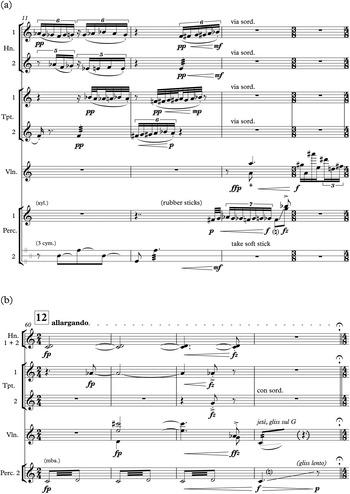
Example 4.13(a)–(b) Crosse, Concerto da Camera, Op. 6 (1962), II: racing percussion gestures
Crosse's language was taking a boldly gestural turn, but then the stylistic profile of all Manchester-generation figures, we have seen, was changing rapidly in the early 1960s. Style and technique – to the extent one can even separate the two – naturally resist synoptic reduction, but increasingly, after about 1961 or 62, the direction in British modernist music appeared to be post-serial. A certain fatigue was discernible in the mainstream avant-garde, as the high hopes of nearly a decade earlier began to fade. There was disillusionment with the possibilities of formalized parametric language, and with the anonymous-sounding uniformity of its results. Alexander Goehr took aim at the situation squarely in a dour newspaper review of the 1961 Donaueschingen Festival: “Different programme notes said the same thing. Several pieces contained improvisatory passages which could well be exchanged from one work to another without great harm to either.”Footnote 111 Goehr's suspicion of the sudden fashion for improvisation could be viewed, retrospectively, as a sign of a coming parting of the ways in British music. Erstwhile avant-gardists – including Goehr himself – were maturing into “young conservatives” devoted to fully notated, thematic-motivic textures, fulfilling commissions for conventional choral, orchestral or chamber forces.Footnote 112 Others, including Cardew and the young David Bedford, were moving away from traditional concert life, towards improvisation and a range of graphic notations.
In the post-serial era, what then were the influences reaching composers in London, Manchester, Oxford, Cardiff or Glasgow? Looking West, they spanned Babbitt, Cage, Carter, and Foss; looking East, they could be said to encompass Ligeti, Lutosławski, and Penderecki; or, further afield, the art-music traditions of India and East Asia (Britten's Curlew River (1964) was widely admired by many younger composers). The formalisms of 1950s twelve-tone methods, whether applied to pitches or to rhythms – bluntly speaking – may no longer have seemed like a way forward to many. Petrassi's encouragement to Crosse – to open up his style, to explore something more “extrovert” – in retrospect, seems timely. Crosse was still involved with row composition in 1962; but, like Boulez, he was coming to realize that technique was only a mirror upon which the imagination might cast an image. The row, the series, the twelve-tone “method” was useful, but it was a means, not an end. The same lesson had been learned in recent years – directly from Pierre Boulez, as it happens – by one more Manchester-generation composer.
Richard Rodney Bennett: respectability and the avant-garde
Just as it seemed as though the whole nagging question of serial, or more generally, atonal music was going to be allowed to rest, with a mutually respectful modus vivendi established between those who see in it the future of music and those who see only a temporary aberration, along comes M. Ernest Ansermet to keep the pot boiling with two lectures …
I want to be a respectable composer, not an avant-garde one. I am not “way out” or a rebel.
Richard Rodney Bennett was quickly singled out among the Manchester generation as the kind of composer who could bridge the widening gap between a cloistered avant-garde and the concert audience. For the men of the London press, Bennett in his early twenties was recognized consistently as “versatile,” possessed of “amazing technical fluency,” and “naturally gifted.”Footnote 113 Similar critical formulations were to echo throughout Bennett's career, alongside charges of mere superficiality. But his music was immediately popular, and not only with progressive-minded critics. By 1966, the year of his Symphony, Edward Greenfield felt Bennett had bridged the mythic gap between, as he put it, “the thinking young composer of the Sixties and the general symphonic audience panting to keep up with modern trends.”Footnote 114 Guardian readers listening to Revolver – the new Beatles album – rather than, say, Momente, may have found Greenfield's remarks too hopeful. Even so, an earlier reviewer had called Bennett “one of the few young composers whose asymmetric rhythms do not sound like a nervous stammer.”Footnote 115 That briefly technical remark (concerning the 1962 Fantasy for piano) homed in on what many listeners missed in the post-Webern wave. Still, it was atonality – rather than rhythmic continuity, or even the presence of serial rows per se – that posed the most significant barrier to the acceptance of new music in the early 1960s.
The Times correspondent who recognized Bennett's fluency also offered a caution: “Bennett's atonal idiom, however full of tonal references, however flexibly handled, is in the last resort a limitation … for him the way ahead may lie backwards, as professional progressives would have it, into tonality.”Footnote 116 This was 1963, the year Ernest Ansermet polemicized against the “heresy” of atonality, prompting the Times to inquire if Bennett and Musgrave, as serialists, were avoiding “full self-commitment to their music” (though Musgrave had by this point abandoned row composition).Footnote 117 Bennett himself offers a sort of reply, two years later, discussing his Symphony: “I do write serially – it's my natural way of composing, although the more I progress the more I think I need tonal references and themes.”Footnote 118 The mutually exclusive binarism – serialism or tonality – epitomizes the loose conceptual terms in which the new was publicly grasped and yet, however limiting, these same terms were influential among composers themselves. When Bennett left London for Paris, in February 1957, it was to study with Boulez in order to assimilate an essentially atonal serial language, of the kind that was barely discussed by RAM faculty. As Bennett's biographer Anthony Meredith aptly notes: “He had gone to Paris wanting to be Boulez, only to return cured of that obsession.”Footnote 119 Bennett arrived back in London in June 1958, aged 22, after fourteen months’ study and with a sheaf of Boulezian compositions in hand; he was increasingly confident in technique, but still uncertain of his own stylistic direction. Having already worked successfully as a film composer (a lucrative sideline he often called his “journalism”), and with pronounced jazz interests, Bennett was readier than some of his colleagues to write in a style accessible to a range of listeners. By temperament, he was no rebel, and he was losing interest in the technical and ideological fervor of Darmstadt progressivism by about 1960 or 61, much as his Manchester-generation colleagues were. In one respect, though, he stood apart: he was, he said, “naturally” a serial composer, and was to remain one for much of his career. As his music of the early 1960s confirms, Bennett was moving beyond the avant-garde, but not beyond the twelve-tone row.
Bennett was soon fulfilling a steady stream of concert commissions, and earning enough to purchase a relatively spacious flat in Islington. The year 1964, for example, saw two significant premieres – the Aubade for orchestra and the Five Studies for piano – along with the completion of a “crossover” score, Jazz Calendar, educational works, string arrangements for Ronnie Scott's jazz albums, and the usual film jobs.Footnote 120 Partly because of the commercial work, Bennett, for a “classical” composer, was already highly visible to a broader than usual public (with the folk singer Jean Hart, he appeared live on BBC 2 television for a time).Footnote 121 Even tabloid critics were writing about his work: the Daily Mail, having welcomed the one-act opera The Ledge (1961), a couple of years later still found it “flabbergasting” that a piece of contemporary music – Bennett's London Pastoral – could give pleasure.Footnote 122
Bennett's commercial success, and his public image as a young and fashionable metropolitan figure, may well have intensified the less flattering judgments of his music – most frequently, the sense that it lacked emotional depth – advanced by high-art commentators. The Symphony was widely praised initially for “immediately memorable ideas,” “spontaneous and expressive melodies,” and for speaking “as comprehensible a modern lingua franca as that of Berg.”Footnote 123 But the praise was not unanimous: Stephen Walsh found “short-windedness” of ideas, and by the second London hearing, the Times worried that virtuosity was “too near to being an end in itself.”Footnote 124 If the latter comment smacks of manufactured criticism – an orchestral showpiece surely requires self-evident virtuosity – the charm and elegance of much of Bennett's work exposed a tension between notions of an unproblematic lingua franca and the modernist valorization of structural complexity or difficulty. Where mid-twentieth-century progressive composers could labor months over a single score, organized by an internal logic with idiosyncratic choices of scoring and a specialist festival audience in mind, Bennett wrote relatively quickly for a range of standard ensembles, and with an ear to what both players and audiences might expect to hear: the Symphony, he told the Times, was “a very direct piece, brilliant perhaps, but simple. It is also a show piece for the orchestra, which is what the L.S.O. wanted.”Footnote 125 With his embrace of the musically direct, Bennett was caught, as he himself observed, between avant-garde and conservative aesthetics: “There's no hope inbetween, which is where I am, along with most other English composers.”Footnote 126
Accessibility and popular success also raised the old specter of British music's vexed relationship to more progressive music from abroad. Peter Heyworth – among the staunchest advocates of Boulez's and Henze's music in the British press – heard in Bennett's music limitations emblematic of a wider failure in the national musical culture: his review of Bennett's opera A Penny for a Song (1967) discerns a growing tendency by younger English composers to “turn their backs on what they a little sweepingly term the extravagances of the Continental avant-garde.”Footnote 127 For others, allegations of British “complacency” were of less moment. In the early 1960s, it was not hard to perceive an age of musical extremes, and to welcome a figure like Bennett, versatile enough to “sort out and profit from the musical upheavals of the last 40 years” (Noël Goodwin).Footnote 128 Yet as the turbulence of the post-war scene dissipated, Bennett's music of the 1960s began to sound like a less impressive achievement: “crisp, energetic, melodious, and contrapuntally lucid,” but also “somewhat inconsequential” (Stephen Walsh).Footnote 129 The chorus of praise greeting Bennett's earliest professional achievements was followed by a fairly damning backlash. The very qualities in Bennett's art observed early on – fluency, attractiveness – provoked a wider spectrum of opinion than that accorded other Manchester-generation figures. Amid such extremes of judgment, Bradshaw's touches on a key point in noting that Bennett cultivated a “stylistic middle ground” rare in the middle twentieth century.Footnote 130
Bennett's early career follows the path of Manchester-generation colleagues in an almost exaggerated way. He was more precocious than even Davies – Bennett's first London reviews date from his seventeenth year.Footnote 131 His interest in serialism had been stimulated by teenage contacts with Elisabeth Lutyens, before transforming itself into an engagement with the latest European trends as intensive as that of any of his peers. But his subsequent retreat from the avant-garde – as technical resource and artistic stance – was, if anything, more strikingly deliberate. Years later, Bennett colorfully described the post-war London scene of his RAM years (1953–56) as a “musical bombsite,” devoid of contacts with the ongoing technical ferment in European music; his embrace of the new was an urgent self-education, but it was followed, for Bennett, by cynicism about the avant-garde as a fashion-prone “circus.”Footnote 132 By about 1960, his music would navigate sharply away from post-war European models. Before turning directly to the scores themselves, the story dwells a moment longer on the biographical outlines of Bennett's avant-garde phase.
Bennett had already attended Dartington by the time he entered the RAM in September 1953. At the Academy, with two new friends – Bradshaw (four years older and in her final year) and Cardew – he revived the New Music Club and began to organize regular performances of a range of twentieth-century repertory from Schoenberg to Boulez.Footnote 133 The three friends hitch-hiked to the Darmstadt Ferienkurse in 1954, where Bennett roomed with a 20-year old Peter Maxwell Davies. Bennett recalls Boulez and Maderna putting down his student work “because it wasn't sufficiently avant-garde.”Footnote 134 It was a criticism he took to heart: he returned annually to the Ferienkurse over the next five years, presenting Four Pieces for Orchestra in 1956 and Music for Two Pianos in 1958 (performing himself with Bradshaw). In 1959, he made a final, briefer, visit to perform in the premiere of Cardew's Two Books of Study for Pianists.Footnote 135 The most famous Bennett–Cardew duo performance had taken place three years earlier on June 5, 1956, after six months’ nightly rehearsal: their performance of Boulez's Structures, Book 1, the British premiere – an “event” reported by The Score and Musical Times.Footnote 136 A few weeks later, back in Darmstadt, Boulez himself coached the two pianists on the work, and Bennett continued his pianistic involvement with Boulez's music by giving the UK premiere of the Ie. Sonate in January 1957. He was 20 years old, and had by now completed his RAM studies. The concert came a week before his departure for Paris, where on a French government grant he became a private pupil of Boulez's.Footnote 137
Bennett withdrew all but one of the scores he wrote as Boulez's student; nearly all were for one or two pianos, but none were ever published. They were written, as his friend Nicholas Maw said, “to assimilate a musical language”; in interview, Bennett speaks of copying Boulez, and going through “a period of being most interested in very advanced things.”Footnote 138 Later on, he openly derided the mathematical aspects of so-called integral serialism, but his music of 1957–58 – for all its subsequent public invisibility – is a signal episode in the British response to the European scene. Bennett's Boulezian works are among the most direct attempts – by stylistic emulation – to come to terms with the post-Webern ethos at the very height of its influence. They were consciously experiments, made under the influence of one of the protagonists. They partake of the paradoxical evanescence of a performed art, for they were played, heard, then firmly locked away. Their “influence” on Bennett's colleagues is hard to pin down, but some influence cannot be discounted. Works of art acquire symbolic status, as Pierre Bourdieu has observed, “only if they are known and recognized,” but in the cultural field of post-war Europe, the cultivation of an intellectual audience – or even the flight from audience – itself marks the site of genuine artistic autonomy, an absolute freedom from market forces.Footnote 139 For the small, specialist audiences of fellow-composers and performers at Dartington and Paris, Bennett's newest works were first-hand dispatches from Boulez's atelier, of great interest as the acme of avant-garde thought. Bennett's “lost” Boulezian experiments are as significant to the collective British modernist cause as published scores by Musgrave, Maw and Crosse already examined, whatever conclusions the composer himself was to draw. Bradshaw, who premiered several of Bennett's scores, in the early 1960s recalled their “brilliance and conviction,” but felt he had adopted Darmstadt ideals “so completely as to deceive himself.”Footnote 140
The influence of Bennett's Boulez-era works, as much as the typical serialized pitch and rhythmic schemes, was pianistic and performative. Stockhausen's 1950s music was fired by the virtuosity of the American pianists David Tudor and Paul Jacobs, among others. It is significant to British modernist developments that Bennett, Bradshaw and Cardew were skilled pianists; with Roger Smalley (and occasionally John Ogdon) they were hands-on advocates of a new pianism closely tied to the moment of integral-serialism. Bennett had heard Tudor's 1956 Darmstadt performance of Stockhausen's Klavierstück V (1954), had a tape of the piece, and in early 1957 began practicing it himself (“rather rewarding”) almost as soon as he reached his Avenue Victor Hugo digs in Paris.Footnote 141 The piece incorporates signature traits of a keyboard-oriented pointillism: delicate grace-note groupings, ultra-precise dynamic and pedal shadings, and silently held chords of resonance. By this point, Bennett was composing a set of piano pieces of his own (later titled Cycle I–IX). He heard them premiered by Jacobs – then resident in Paris – at Boulez's much-watched Domaine musical concerts in January 1958 (“Paul played my pianostücken admirably”).Footnote 142 A French critic compared them stylistically to the “most recent language” of Boulez and Stockhausen.Footnote 143 Stylistic conclusions must await access to the scores; meanwhile, Bennett's structural-compositional ambitions are themselves evident from extant documents.
Writing to Bradshaw in 1957, Bennett's descriptions of his Cycle are couched in the technical lexicon of the “most recent” language: “All sorts of new principles (for me) involved, particularly that of complexes of notes whose order is free within the complex, & also complexes built upon the original series, i.e. not the series used horizontally. I think I'm finally getting away from the ‘motif’ idea of the series towards the idea of it as a structural base … I do find that I want to write very loud & fast music suddenly, with lots of lovely long silences! Rather strange but at least leading me away from that fatal ‘lyricism’ …”Footnote 144 The idea of a set of numbered “Stücke” matches Stockhausen's genre model, and Bennett's letter shows a self-conscious replacement of the Schoenbergian notions of the series as theme by the Boulezian “complex,” by a discourse of types of sound, and the Stockhausen-esque exploration of punctuating silence; “lyricism” at this historical moment, is suspect.Footnote 145 A program note confirms Bennett's interest in structuring non-pitch parameters: “No. 1 is based on sonorous, harmonising complexes, limited in number; their mood varies according to the modifications imposed on their register, their length and their dynamics.”Footnote 146 The histrionic aspect of this idiom is evident at the close of the brief Two Pieces for trumpet, cello and piano that Bennett completed while processing the “new principles” he was encountering with Boulez (see Figure 4.1).Footnote 147 The constantly shifting dynamic levels, and the rapid traversal of extremes (by ppp to ff “hairpin” crescendo, for example), affirm amplitude as a discrete musical parameter. At a rapid clip (eighth=112), the piano's martellato groups fuse into sprays of notes from both ends of the keyboard, a fraught cadential lunge, to which the trumpet and cello append their own curt sign-off gestures; Bennett was indeed escaping a “fatal” lyricism.
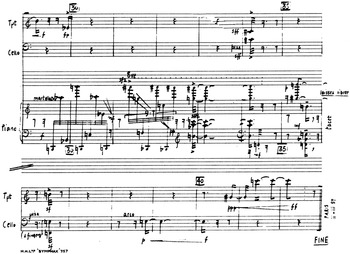
Figure 4.1 Richard Rodney Bennett, Two Pieces for Trumpet, Cello and Piano (Paris, February–March 1957), ending.
Clearly, serial composition was the topic on the 20-year-old Bennett's mind: subsequent letters breathlessly mention studies of Schoenberg's Fourth Quartet, admiration for the Webern Trio, and acquisition of French recordings of Webern, Nono, Stockhausen, and Boulez, as well destroying a sketch he was unhappy with (“the most awful cod-Webern”).Footnote 148 The lessons with Boulez proved illuminating: besides critiquing his young student's latest scores, the Frenchman assigned Bennett to study Second-Viennese repertory in preparation for long analytic discussions.
Structuralist-serial preoccupations were clearly to the fore in another early 1957 score, the Study for trumpet and piano, commissioned for Britten's Aldeburgh Festival. This was a more public venue than Dartington, but Bennett's program note again emphasizes “construction” of “a limited group of material which is constantly varied within itself. The writing is not contrapuntal, but consists of a continual superposition of varying timbres, complexes of sound (vertical and horizontal) and different speeds of movement.”Footnote 149 If the integration of horizontal and vertical recalls Schoenbergian ideals, the focus on timbre as parameter was a post-war trope, informed by electronic music, still more or less absent in 1950s British modernism, but central to the European avant-garde by 1957. Bennett's Music for Two Pianos, and his Studies for five winds and percussion were also played in 1957 (at Dartington). The latter piece, Bennett observes, comprises “variations divided by solo cadenzas, using a peculiar sort of mirror-form idea which I've used in no. VI of my piano pieces.”Footnote 150 Only one of his Parisian works, apparently, satisfied Bennett. This was Cycle II for Paul Jacobs, premiered by Jacobs in Paris in April 1958, and toured internationally by the same pianist in 1960. A single London performance (April 1960) moved a Times reviewer to describe a score in which “single notes are made the pivot of flamboyant, disturbing eruptions of sonority while two contrasted moods are whittled down to their minimum dimensions,” and to complain of its similarity to Stockhausen's Klavierstück V, also on Jacobs's program.Footnote 151 Bennett felt that in Cycle II he had “let go, slightly,” especially in terms of harmony (“it wasn't to do with arithmetical series or the usual rubbish that we were doing then”).Footnote 152
The “arithmetical” remark – and Bennett's uncharacteristically blunt criticisms of Cardew's Two Books of Study, in 1959Footnote 153 – signaled a process of distancing himself from the avant-garde that began almost as soon as he returned to London in mid-1958. But it would be a mistake to overlook the lasting impact of the Boulez apprenticeship on Bennett's later style. He continued to perform Boulez's music: he played percussion in early British performances of Le marteau, including the 1959 Dartington performance – celebrated for Cardew's mastery of the guitar part, which he had painstakingly learnt over many months (never having previously studied the instrument).Footnote 154 With Bradshaw, Bennett also published closely technical discussions of Boulez's idiom, and his interest in Stockhausen was equally clear. He performed the piano part in the 1960 British premiere of Gruppen in Glasgow, and contributed a program note praising the work's “vast sweep and power.”Footnote 155 By the mid-1960s, though, Bennett's outlook had shifted: in a published profile, he singled out Henze as an uninhibited “romantic,” a composer who had escaped the “cage” of the avant-gardeFootnote 156 As usual, the verbal labels (avant-garde, romantic) gesture loosely at broad areas of technique and expression in what the Times, profiling Bennett, had called an “age of stylistic confusion.”Footnote 157 Historians are in danger of over-dramatizing the distance between a late-1950s avant-garde and music composed only a few years later. To eyewitnesses in the early 1960s, though, change was very much in the air, and Bennett's progress was something to watch closely.
A song, This Worldes Joie, written for Josephine Nendick in 1960, is representative of Bennett's emerging independence of voice after returning from Paris (see Example 4.14). Unsurprisingly, it is far removed, stylistically and technically, from the more directly neoclassical idiom of Bennett's RAM days, the style of the 1954 Piano Sonata (also shown in the example). That both pieces are serial seems incidental, since using twelve-tone rows for Bennett is an entirely routine procedure. The more telling contrast comes in the song's greater technical and expressive range: harmonies and rhythms are more diverse in make-up, ideas are more supple in their growth processes. Where the Sonata has irregular but still-periodic metric groupings, the rhythmic approach in the song is gestural and declamatory. The opening chordal figure – initially with biting attacks, later on more smoothly articulated – acts as a refrain. The first three verticals complete a chromatic aggregate, while the fourth, on D♭, begins a creeping half-step motion away from D, the starting “tonic,” to be restored with the bass arrival in m. 5. In Bennett's resonantly spaced chordal flux, multiple harmonic affiliations – both vertical/chordal and horizontal/melodic – accrue. Each of the four refrain chords is intervallically distinct, yet the upper-treble sevenths (F/E♭ and E/D), as the next phrase unfolds (mm. 2–3) become anchoring bass pitches, reconfigured as ninths. Of triads or key there is little hint, though the free-floating atonality is shot through with rich colors and Bennett's minor sevenths (over C, m. 5, and B♭, m. 6) have a jazzy lushness. In the intimate world of voice and piano, Bennett evades the avant-garde tendency to score for esoteric forces. Another piece from 1960, Calendar for chamber ensemble, displays kaleidoscopic shifts of timbre, but sounds short-winded in its restless reconfiguring of fragmentary wind, string and percussion phrases. This Worldes Joie, tied to the single soprano voice, breathes the air of melodic continuity. In a mostly syllabic text setting, Bennett once again allows himself that which he had previously denied: lyricism.
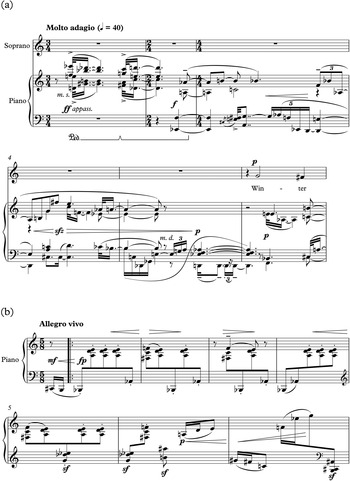
Example 4.14(a)–(b) Richard Rodney Bennett: This Worldes Joie (1960); Sonata for Piano (1954): openings
In the early 1960s, Bennett finessed his rhythmic language – disciplining, not necessarily simplifying, the details – and returned to a proto-Classical rhetoric of balancing phrases. His music had always sounded “lucid,” but the new direction, and his flair for refined instrumental colors – as in the orchestral Aubade (1964) – resulted in scores of striking elegance. The Five Studies for piano (1962–64) took Schoenberg and Bartók as a conscious model,Footnote 158 but could hardly be mistaken for music of an earlier decade, for Bennett avoids the trappings of avant-garde pianism he had so eagerly embraced while in Paris. In the first study (Example 4.15), the opening swaying interplay of left and right-hand chord streams is languidly flessibile in rhythm: the Debussian tendency is to quickly restated ideas with subtle variation (compare the exchange of dotted and simple eighths in the first 5/16 bar and its longer double, m. 2). Harmonically, the music is even richer in vertical sonorities than This Worldes Joie, more luxuriant in allowing resonance over the low bass. A harmony of pedal points recalls Messiaen and Boulez, though Bennett's chords have a tintinnabulating ring all their own. The language is rich in trichord sounds gleaned from the chosen pitch row, and fleeting triadic glimpses: a not-so-buried A♭ dominant-seventh chord (m. 2), eventually slips down to the prominent seventh over G (m. 5), for instance.
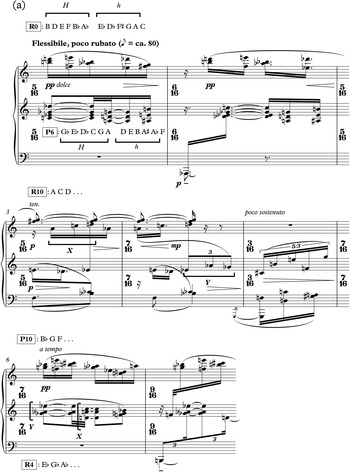
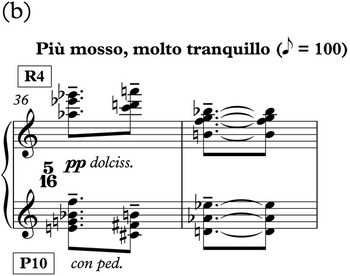
Example 4.15(a)–(b) Bennett, Five Studies for Piano, No. 1 (1962): row choices at the opening, and in the reprise
The closing reprise section (più mosso, also shown in Example 4.15) is a shadow of the opening: left-hand chords are identical in voicing, but transposed up a major third in relation to m. 1 (so reprising the row hexachords of mm. 3–5, but in retrograde). The palindromic symmetries ultimately extend to the entire Study.Footnote 159 The formal mirroring springs naturally from Bennett's choice of a row-form that is internally a palindrome (the second hexachord, h, being the retrograde inversion of the first, H). Bennett keeps chromatic aggregates in play in the classic Schoenbergian way, by running pairs of rows whose hexachords combine crisply, as six-plus-six pitches, without doublings. Bennett's grasp of such techniques, possibly discussed with Lutyens as a teenager, was likely expanded by the analyses he made under Boulez's supervision.Footnote 160 The combinatorial pairing of Prime and Retrograde row forms, applied throughout Study 1, maintains a consistent harmonic ambience within a background cycle of row-form choices, with pitch overlaps between hexachord areas.Footnote 161 For example: the right-hand melody pitches A and C in m. 3 simultaneously complete the “missing” notes of the R0 row (mm. 1–2) and start a new R10 form (mm. 3–4). They initiate a broader play of returning ideas: thus trichords x and y are heard melodically (mm. 3–4: see Example 4.15), then as vertical chords in the left hand (m. 6, as part of the R4 row). Such fluently self-reflexive row unfoldings produce telling moments of expressive detail: another aspect of mm. 3–4, the repeating F♮ bass, soon blossoms into the euphony of an F-major hexachord (m. 6); or listen for the rhyming of brittle E/F sevenths in mm. 1 and 6, a returning color within contrasting harmonic fields.
Working with a patterned row – comprising four (025) trichords – and a circumscribed universe of twelve-tone regions, the first of the Studies offers a relatively slow turnover of row forms and hexachords: mm. 3–7 run just one row pair, followed by its retrograde.Footnote 162 The technique is apparently systematic – a cycling-through of row forms over the course of the piece. Bennett's kaleidoscopic pitch overlaps and trichordal echoes may, as Bradshaw observed, reflect a reworking of “ideas on harmonic proliferation learnt from Boulez.”Footnote 163 But Bennett's interest in rhetorical doublings is something personal, too; in planning the “outer” form of his music, he is apt to find ways of disguising large-scale repetitions. In the Aubade for orchestra, for example, the A section itself describes a smaller aba pattern, with wind and strings scoring “reversed” in the second a.Footnote 164
By 1965, when Bennett wrote his Symphony, his reputation for direct communication was unparalleled among his own generation of progressive modernists. That image was further enhanced by broadly favorable reviews of The Mines of Sulphur at its Sadler's Wells premiere.Footnote 165 The operatic experience had a real bearing on the Symphony, which Bennett described as an exploration of a world of feeling germane to his next theatrical project, the comedy A Penny for a Song (premiered in 1967). After a period of somber “nocturnal” works, he sought to write “something brighter, harder and clearer.”Footnote 166
The Symphony was a bold return to an archetype, the most imposing and historically freighted of instrumental forms. “Symphony,” in general, proved a difficult word for twentieth-century composers; Bennett was tackling a form his own generation largely steered clear of in the 1950s and 60s. Where multi-movement ensemble pieces did appear, they often gestured to pre-Classical models (as with the Monteverdian borrowings in Davies's Sinfonia); or “qualified” the genre associations of symphonic discourse, by economies of scoring or scale: Goehr's Little Symphony uses reduced wind and brass sections; both Crosse (Symphonies, Op. 11) and Anthony Gilbert (Sinfonia, Op. 5) wrote for chamber orchestra, and the pieces are under fifteen minutes in duration. The avant-garde rejection of Classical forms and the post-Stockhausen suspicion of traditional thematic “development” are factors. Meanwhile, in Britain, a post-1945 tradition of “Cheltenham symphonies” – by Searle, Hamilton and Fricker, among others – had arisen. These were accorded respect, but after Vaughan Williams's death, the full-blown symphony was less cultivated. Even Britten, with the 1963 Cello Symphony, slyly evades straightforward genre expectations.
Bennett's concept of symphony retains neoclassical respect for the inherent balance of melodic periods already noted in the Studies, and his Symphony (re-named “No. 1” when a successor appeared in 1967) favors a schematic clarity in defining phrase and paragraph. In Bennett's serialism, moreover, a symmetrical division of the row into two hexachords frequently matches the symmetrical balance between antecedent and consequent phrases.Footnote 167 Such atonal neoclassicism, as Arnold Whittall has noted, was promoted in the 1950s in the teaching of Seiber, and in Searle's Twentieth Century Counterpoint text (1954), for example.Footnote 168 But the neoclassic “compromise” (as Whittall goes on to say), between conserving old phrase forms and pursuing the air of other planets, harmonically, requires a developmental intensity distinct from the sharp juxtapositions of post-Stravinskian “block” rhetoric. For Whittall's taste, some of Bennett's early 1960s works – including the Fantasy (1962) for piano – were simply “too well behaved” formally.Footnote 169 Such charges are in keeping with Boulez's rejection of serial Schoenberg, and the critics’ reservations about Bennett; approaching the 1965 Symphony, then, a listener might well ask how musical telos – an ongoing logic that pushes the argument forward in meaningful ways – comes about, if not by the traditional tonal motions of key definition, tension, and return?
The abundant dramatic excitement in Bennett's Symphony unfolds in a post-triadic language in which traditional intervallic notions of “consonance” and “dissonance” must be refashioned for an all-chromatic landscape. While succession of pitch levels matters a great deal, Classical key relations have been replaced by a hierarchy among row forms. By associating changes of row form directly with the outer, rhetorical form of phrases and subject groups, Bennett communicates a symphonic drama of long-range tonal maneuvering.
Bennett's Symphony is among the more thematically forthright modernist scores of the period. When Musgrave and Goehr wrote wholesale “da capo” repeats into their scores in 1961, they were following a Classical practice little known in avant-garde circles of the preceding decade. Bennett, four years on, does not use repeat-signs, but leaves listeners in little doubt as to when central ideas return. The vigorous opening tune (Example 4.16) bursts forth, hurtling down a sharply twisting melodic pathway, yet its cascade of ideas traverses clear repetitions: of the opening phrase (1a), with its sennet-like opening motive; and of the answering accelerando group. The entire passage announces five main ideas (1a–e), the first (1a–b) heard twice, the second statement exactly repeating, then extending the opening. Remaining phrases (1c–d–e) spin out the pool of rhythms and intervals already under discussion, and the paragraph reaches cadence in the form of an extended chordal pedal.
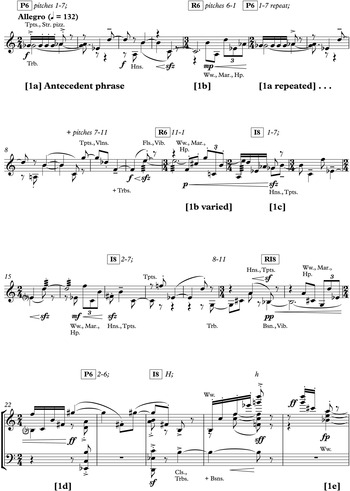
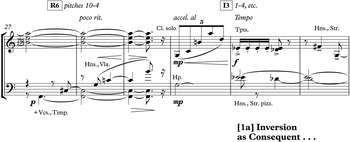
Example 4.16 Bennett, Symphony (1965), I: motive and row-form segments in the first-theme Antecedent phrase
The first-subject group (shown in part in Example 4.16) folds down the middle into two balancing halves (mm. 1–30; 31–60): a greatly magnified antecedent-consequent design. The basic parallelism of the period phrase is reinforced by the melodic logic of inversion, for the music after m. 31 sounds a direct retelling, through the inversional mirror, of the melodic story so far. Bennett is too much the musical dramatist to invert mechanically, though, and while the consequent appears near-symmetrical, string contributions and some rhythmic details are intensified. By a traditional kind of orchestral signaling, the ending of the entire first-subject group is marked by the timpani roll.
Glittering and variegated scoring disguises material that is daringly simple – a single-line melody inhabiting the middle register. There is, too, an underlying simplicity of pitch arrangement that plants germinal motives firmly in the listener's ear, elucidating harmonic motion within a fully twelve-tone setting. The first-subject complex (1a–e) already described comprises a single Prime-form row (P6), then an Inversion (I8) chosen to reverse the direction of the initial motto (A♭–G♭, instead of G♭–A♭). The music's palindrome-like retracing of steps keeps a given row form in play, so that the first P6 phrase (1a) is followed immediately by its pitch-Retrograde (1b), the pair repeating in extended fashion before the introduction of a new phrase (1c, m. 13), itself answered by a retrograde. By such expository maneuvering, Bennett spins the entire antecedent paragraph from two row forms plus their retrogrades.
Because the line is monophonic, the harmonic field of the opening remains lucid, evolving slowly (only at m. 20, e.g., does the twelfth chromatic pitch, B♭, make its appearance). There is no need for Bennett to “thicken the sauce” (in Goehr's phrase) by doubling row forms to create counterpoint.Footnote 170 The chosen pitch levels regulate the circulation of the twelve chromatic pitch classes and a sense of tonal distance between rows. Phrase 1c's row (I8) is harmonically close to the “home” P6 (since half-rows (hexachords) share four common-tones), and as the strict unison writing accumulates punctuating chords, the complete texture again prolongs the first seven pitches of the P6 row (mm. 22–24). When Bennett's first-subject group reaches its large-scale fold, the new row form presents significant shuffling among pitches (I3 hexachords hold only two common tones with P6, three with I8).
Soon after writing the Symphony, Bennett observed in his own music “a rather self-conscious approach to form, where all the material is ruthlessly inverted, ‘retrograded,’ or built into palindromes or other small forms.”Footnote 171 While this self-conscious attitude to form – as if to ensure that listeners will know at a given moment exactly where the argument is going – is evident at the largest level of the first-movement sonata scheme, and yet with Bennett, the clarity communicates dramatic action. The drive of the transition (mm. 61–112), for example, depends not only on a leavening of pitch materials (moving away from the home P6 territory, that is), but on forceful rhythmic shifts. Where the first subject's stentorian fanfares communicate a busy subdivision of tactus, the wide-limbed triplets that interpolate earlier figures (at mm. 63 and 73) have a more carefree swagger. The shifting metric argument paves the way for heavy brass attacks that banish, once and for all, the weightless mid-register world of the opening. This “big-band” gesture (mm. 81 ff.) – redolent of the jazz language of Bennett's film work – provides the foil to a vulnerable high string cantilena, and the dialogue of brass and violin characters continues into the second subject.
After so patent a contrast of thematic agents in the exposition – athletic first theme, angst-ridden lyric second – the compact development (mm. 129–79) pursues more fragmented thematic transformations, reserving theatrical revelations for the closing stages of the sonata cycle. Bennett's recapitulation, by reversing the order of thematic groups, reworks its original dramatic sequence, but the most haunting effects are, again, accomplished through memorable orchestrative choices, a theatrical disguising of principal thematic characters. The second theme, returning “early” (m. 180), is untransposed in the violins, but its accompanying brass chord layer intensifies into a fully chromatic shriek. From this climax of vertical-intervallic angst, a transfigured first theme steals in, at first recognizable by its thrumming martial rhythms, a spectral outline behind a scrim of string harmonics. It is the kind of orchestral change of costume that Bennett excels in, but such delicacy does not endure. The movement ends by silencing the woodwinds, who are brutally overpowered in a hasty close driven on by the returning big-band motive. With gestures of such direct and unmistakable force, Bennett was playing to his natural strengths as a composer. Accommodating glittering post-triadic harmonies to a neoclassical balance among phrases, he was also – like others of his artistic generation – seeking to communicate with a broad audience.
























